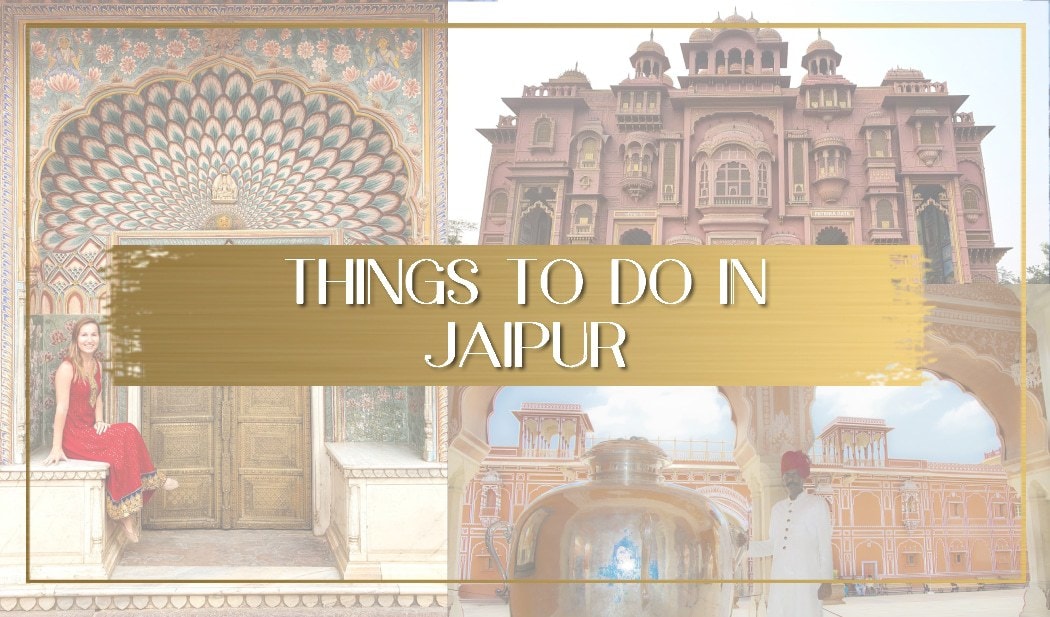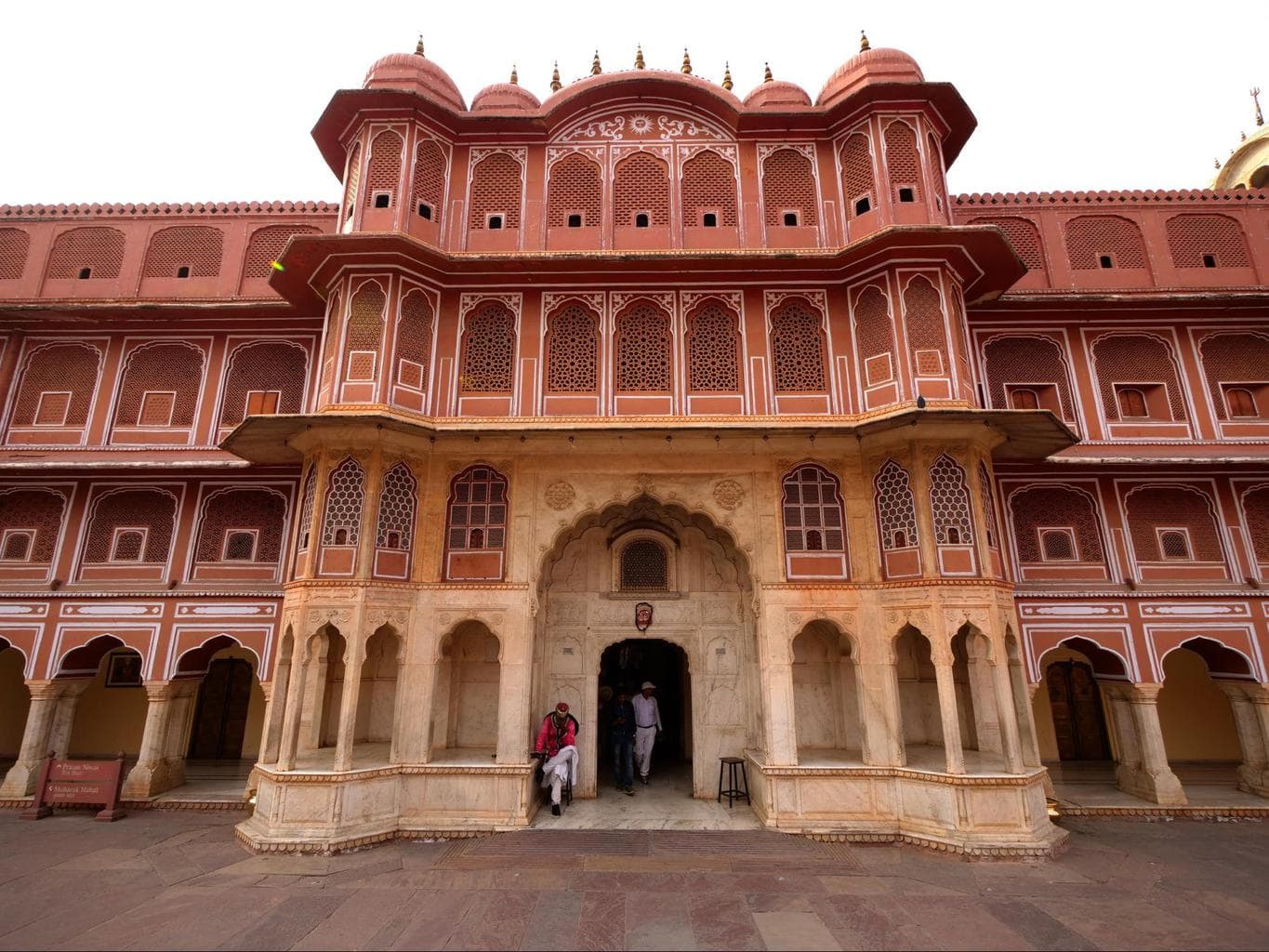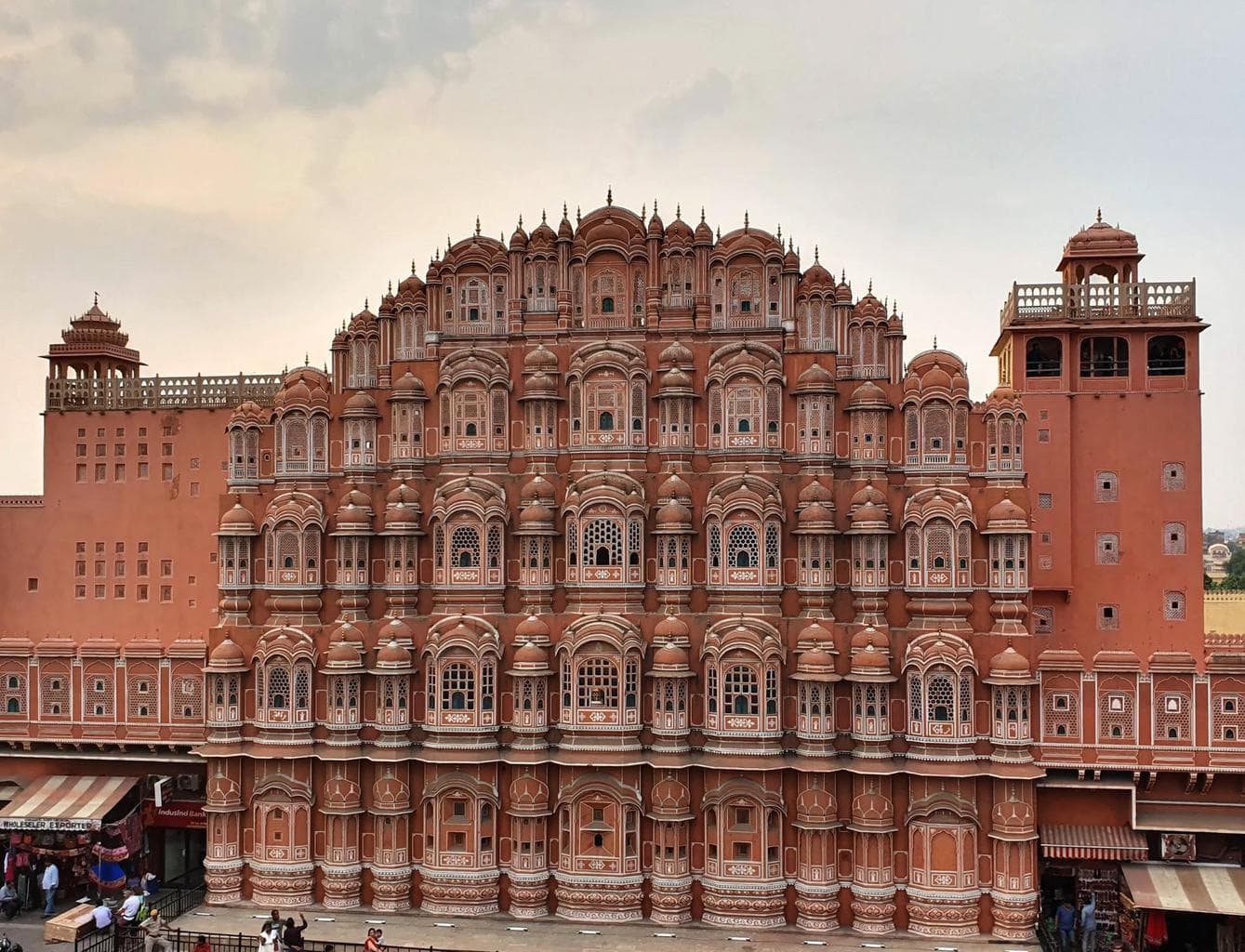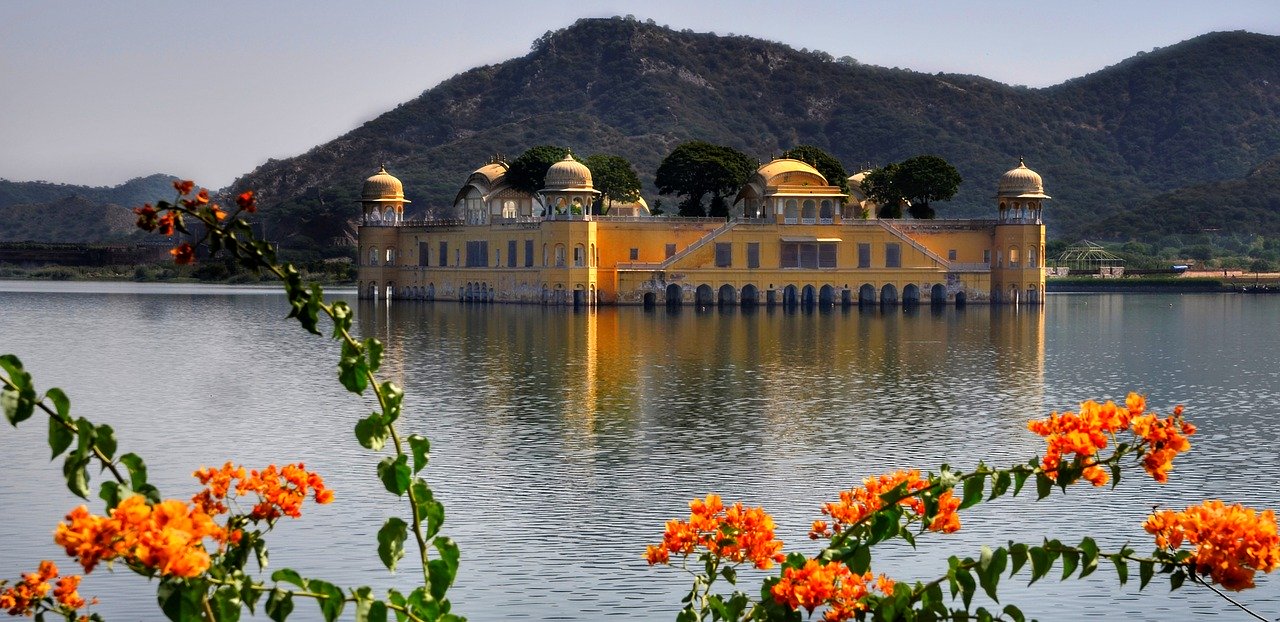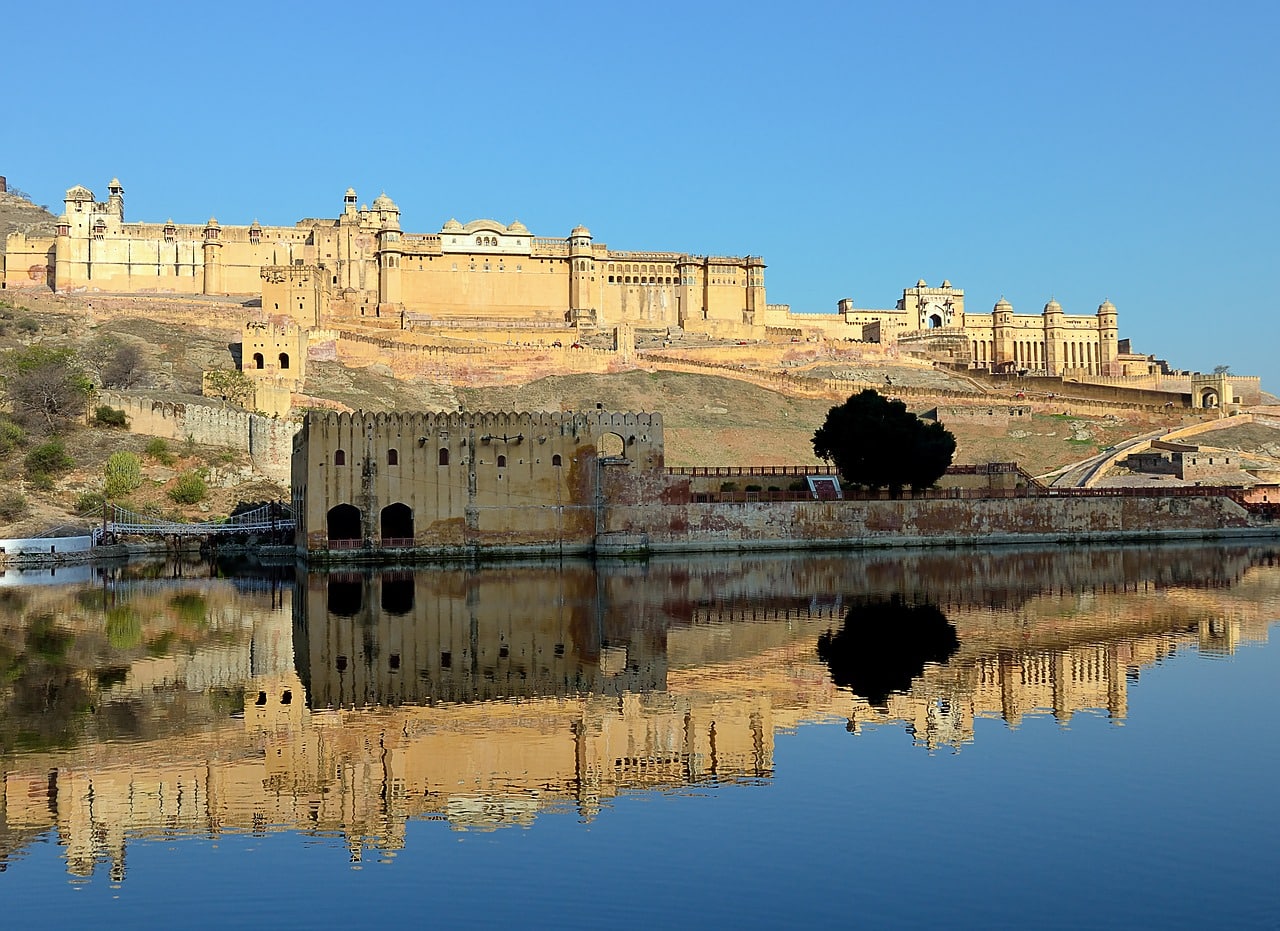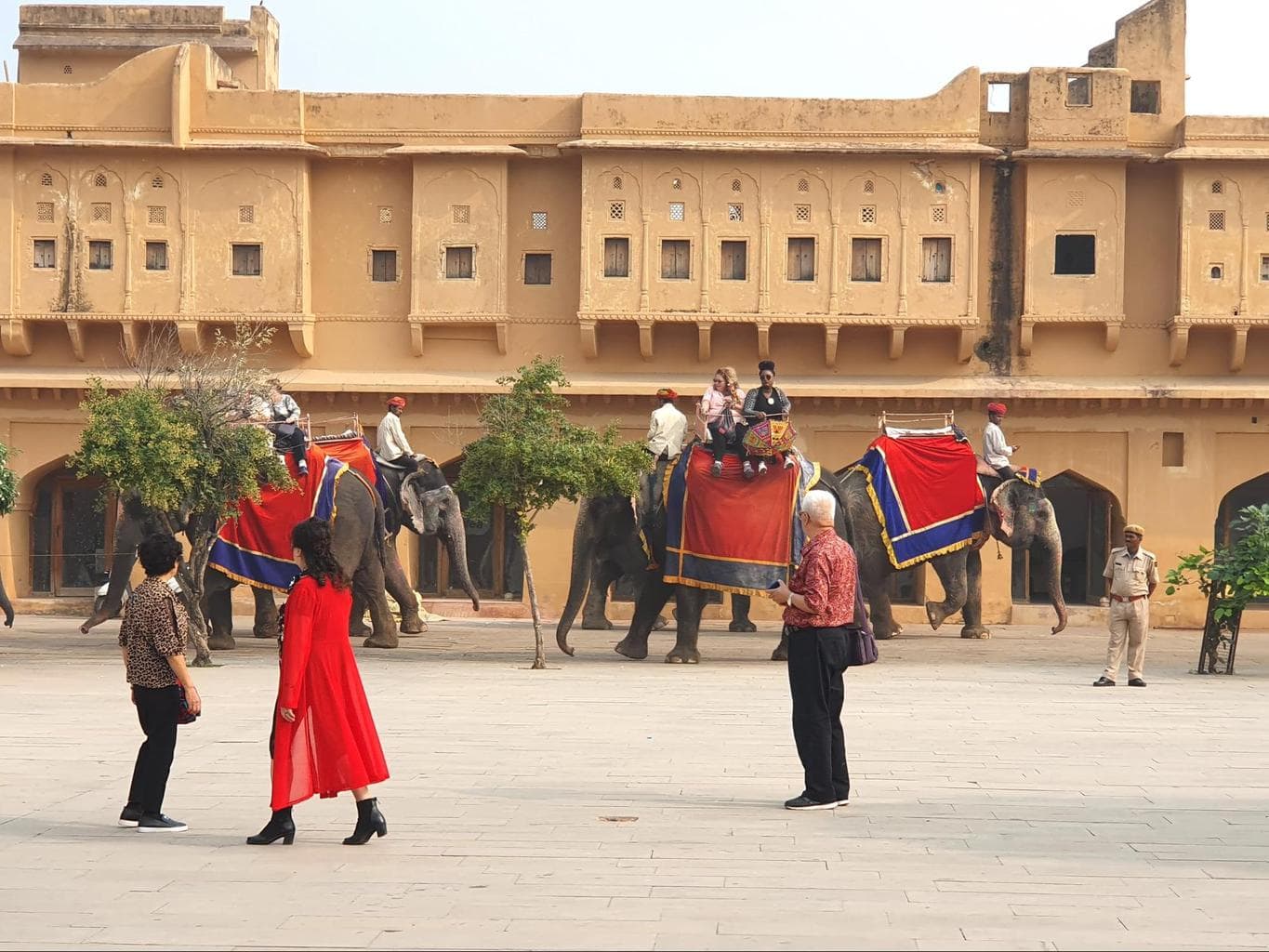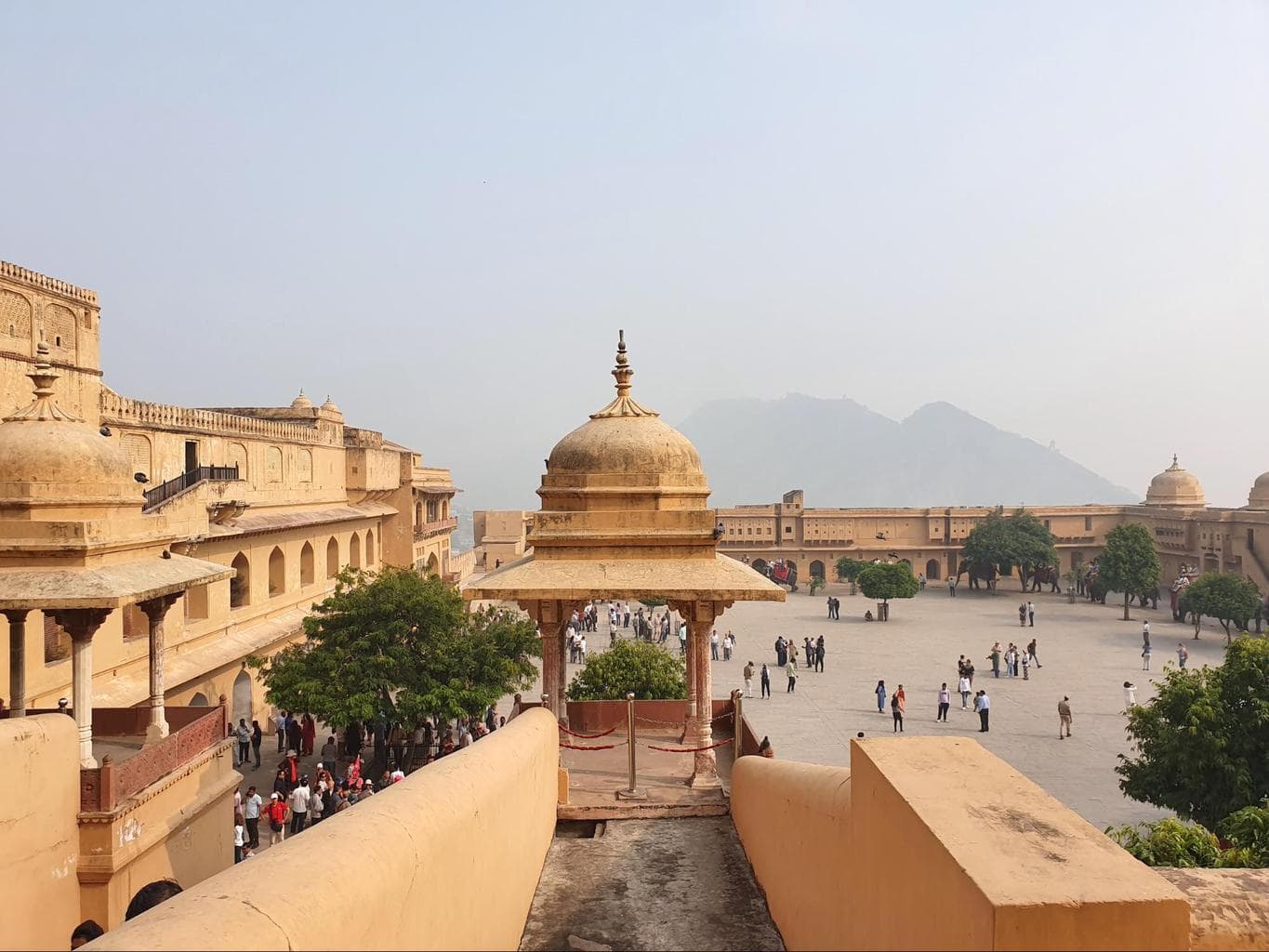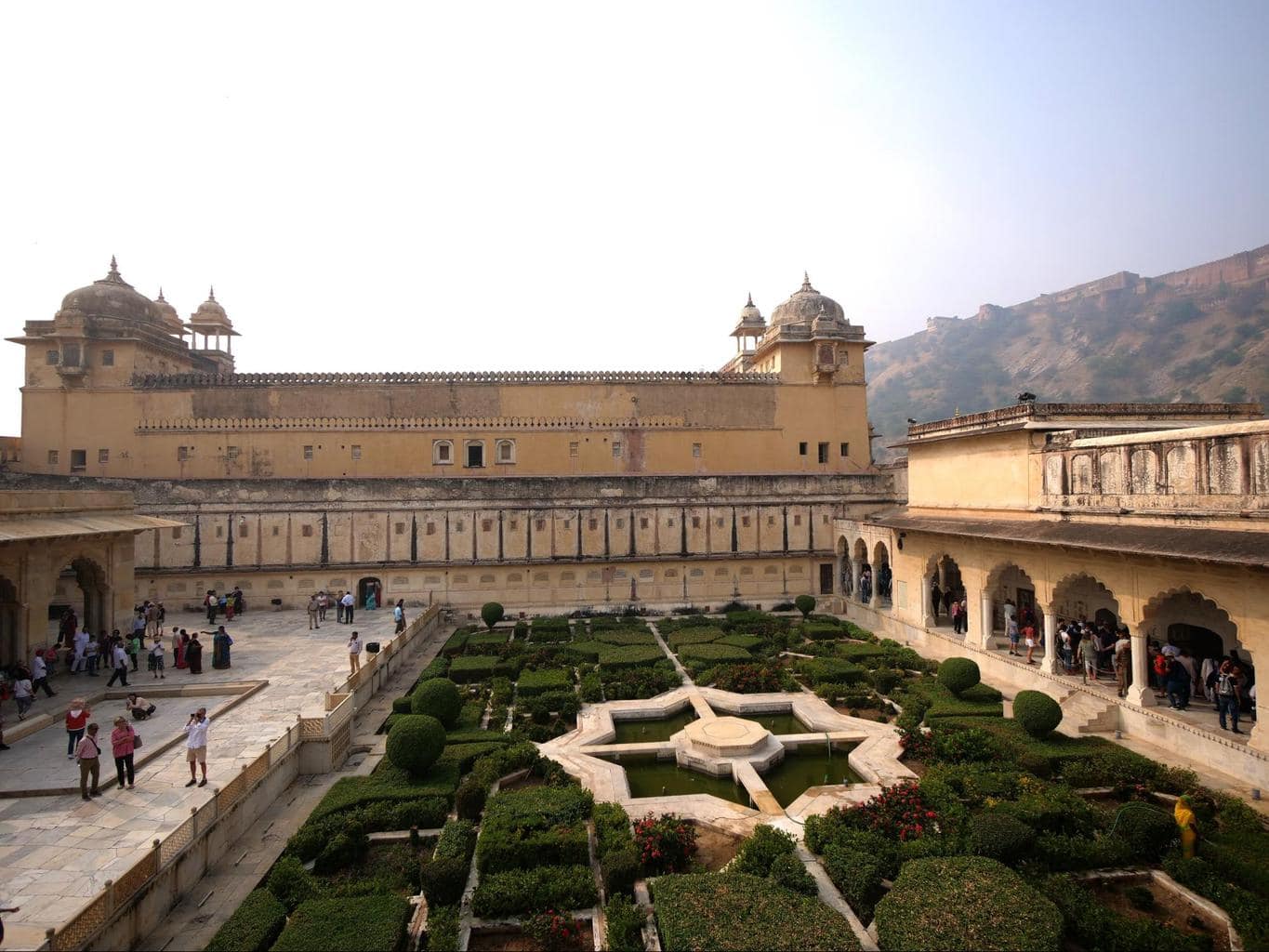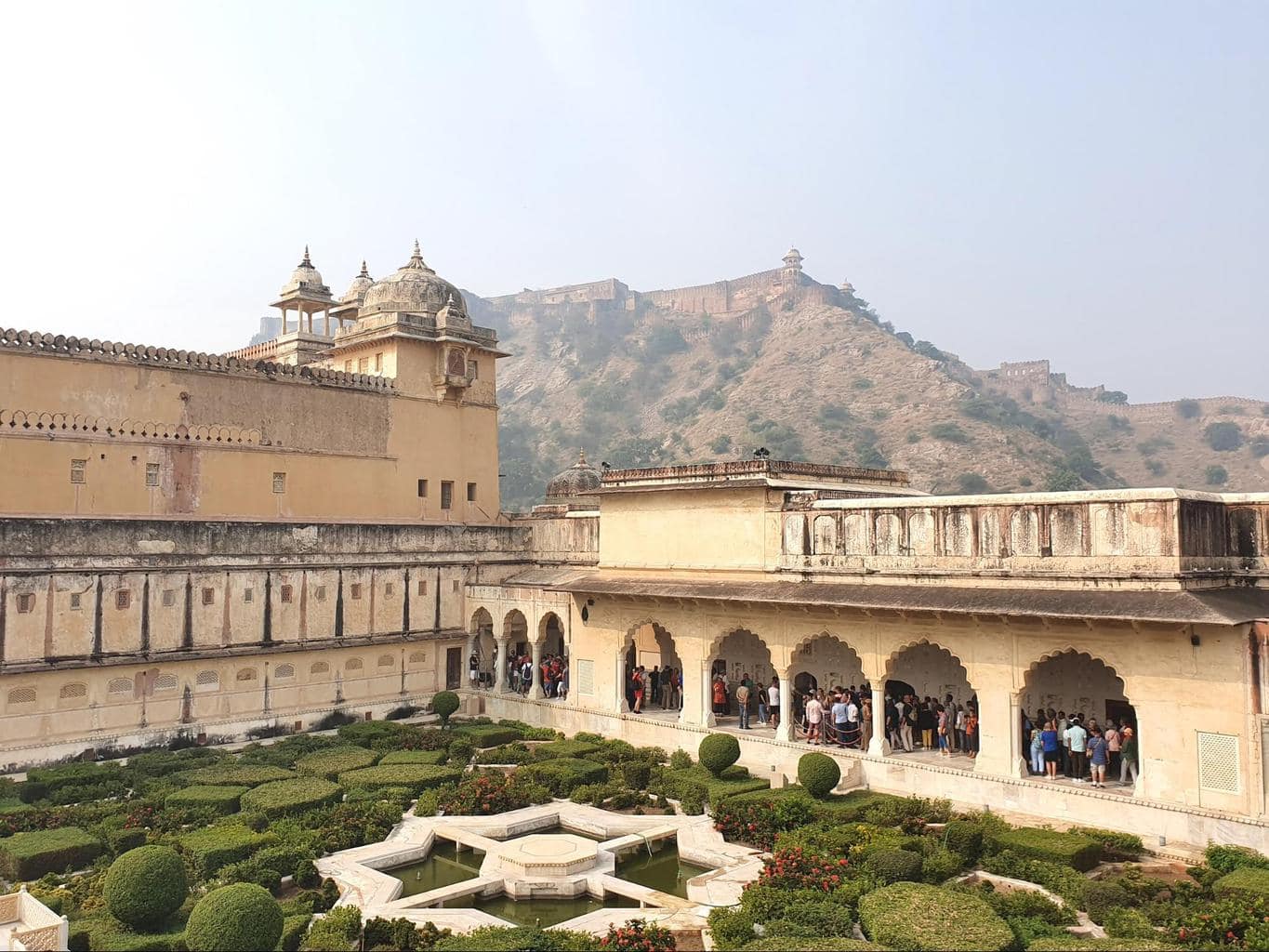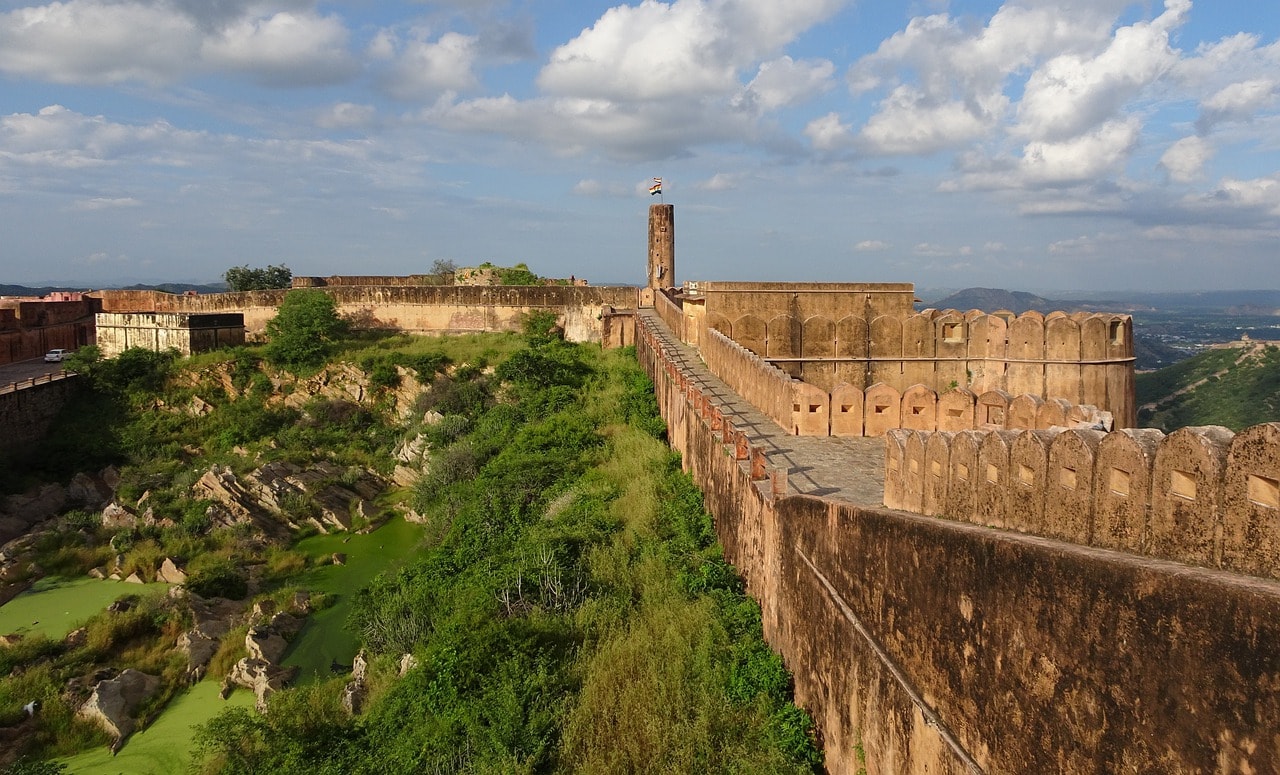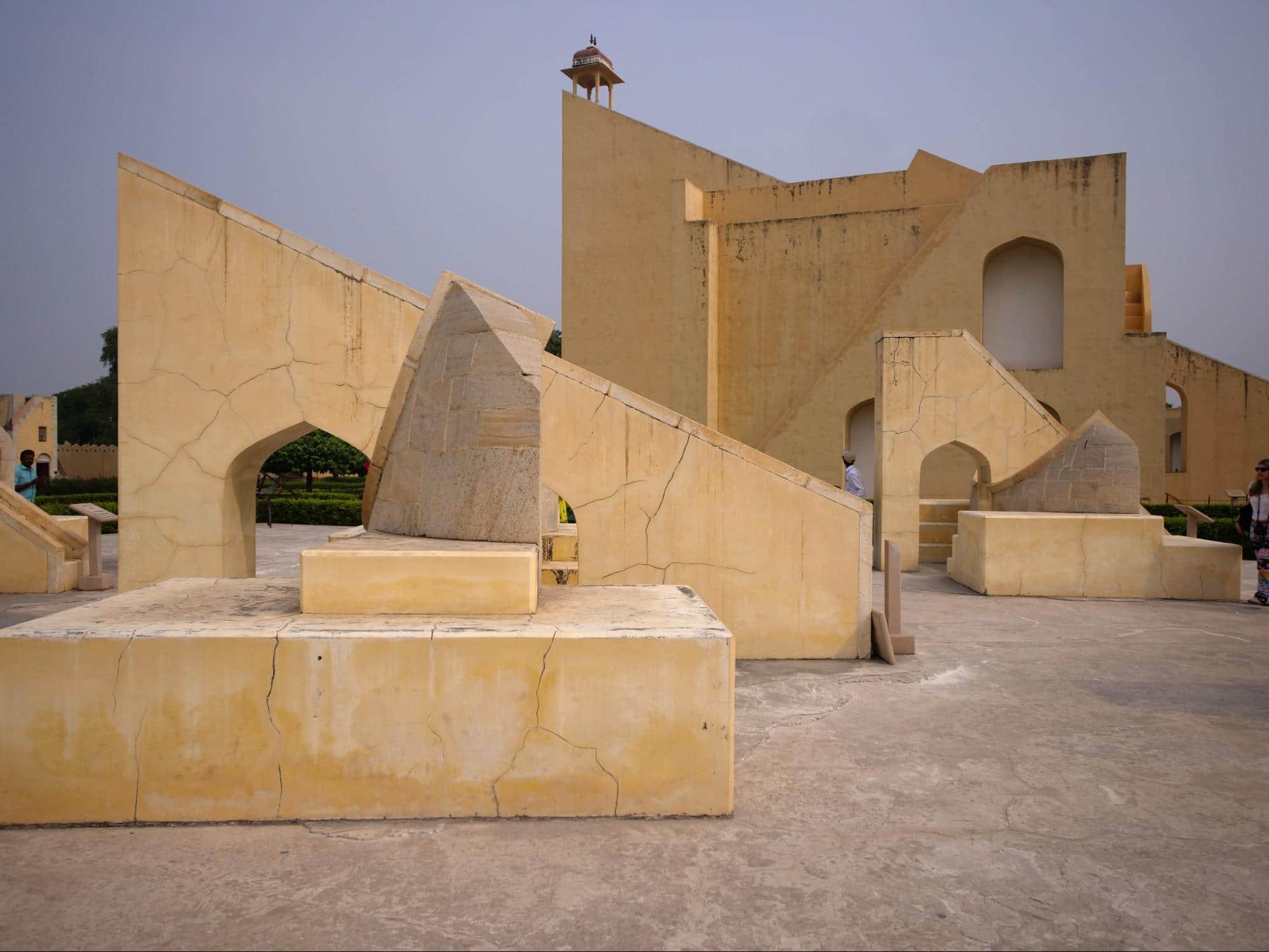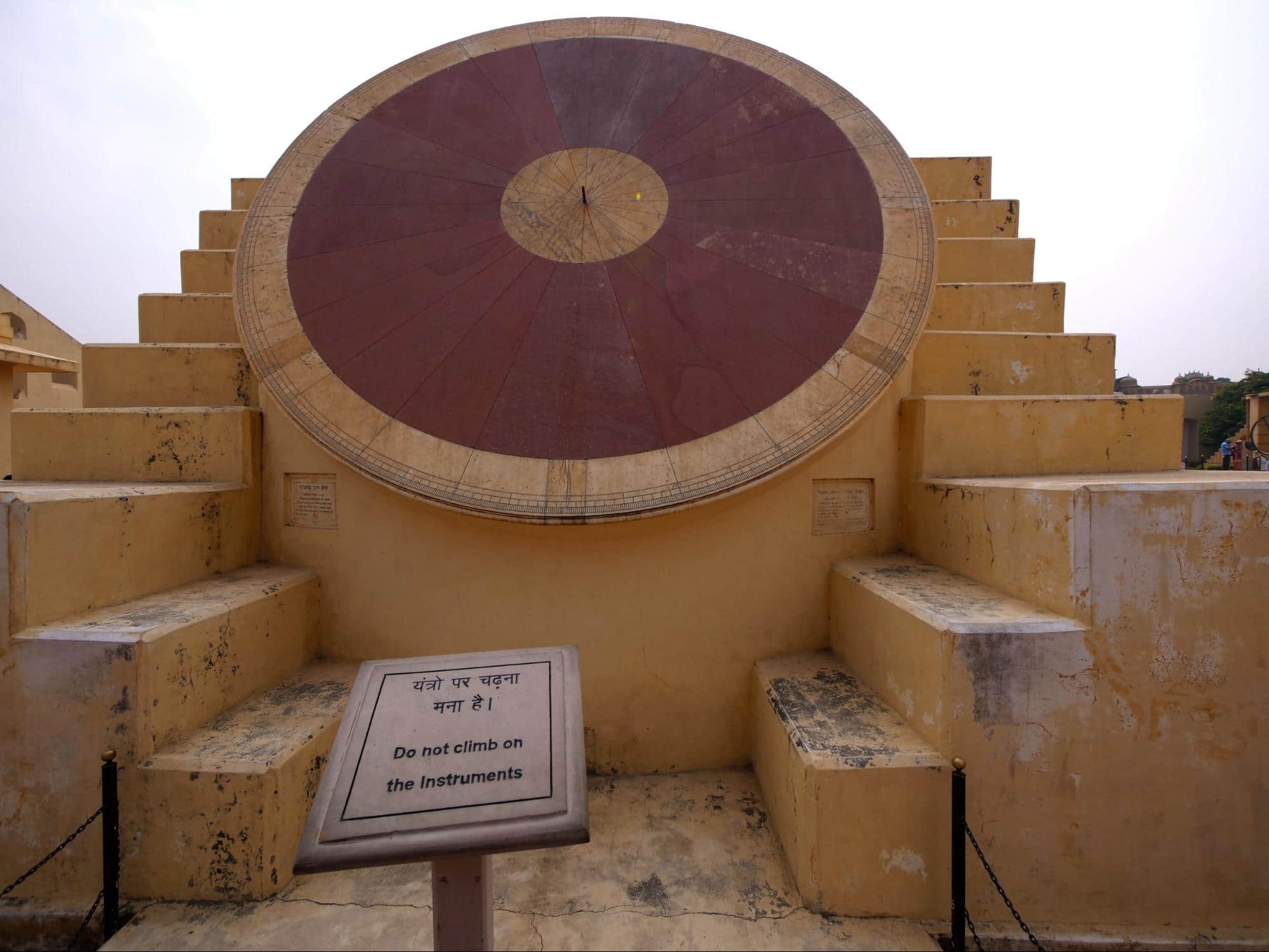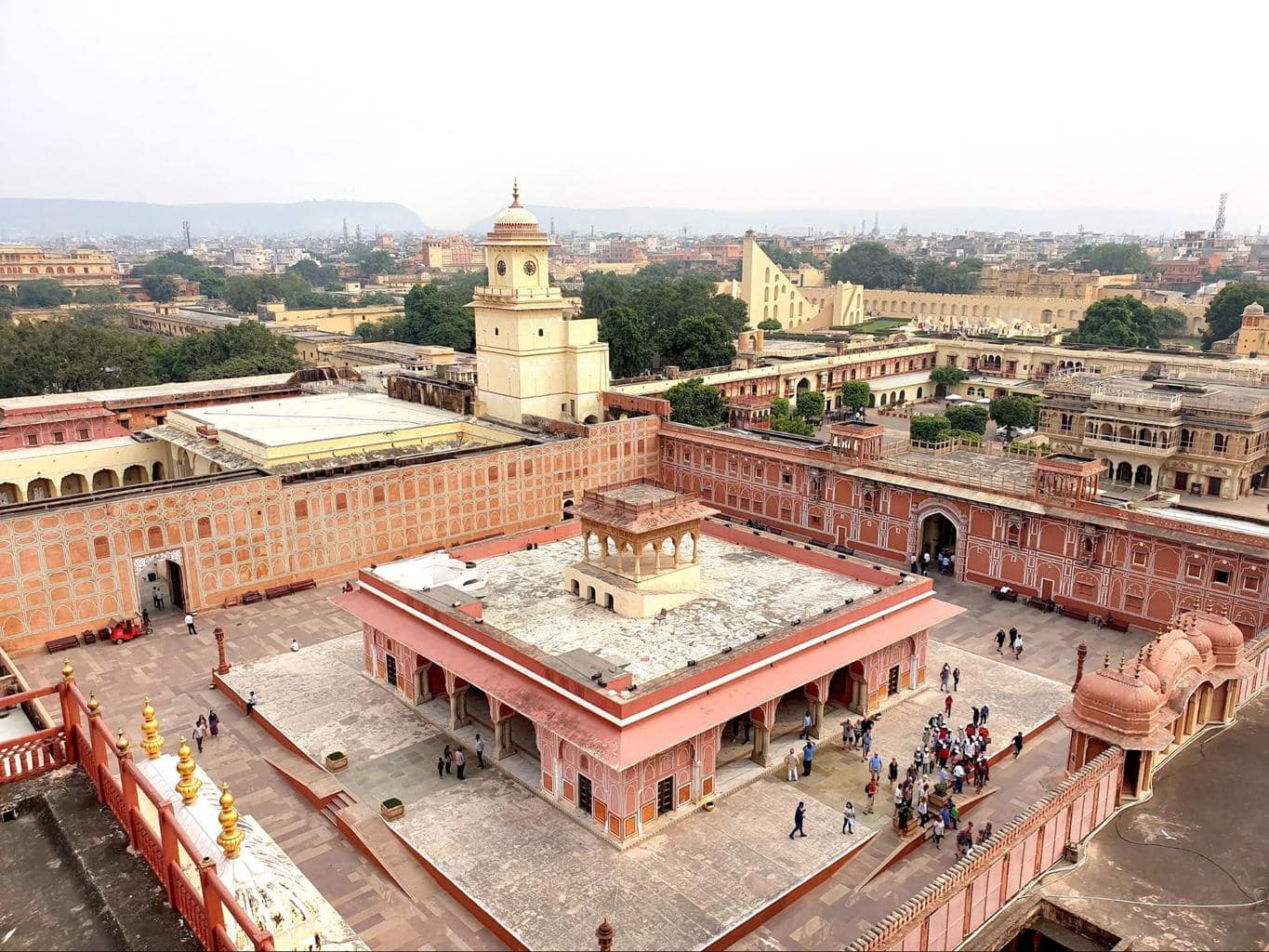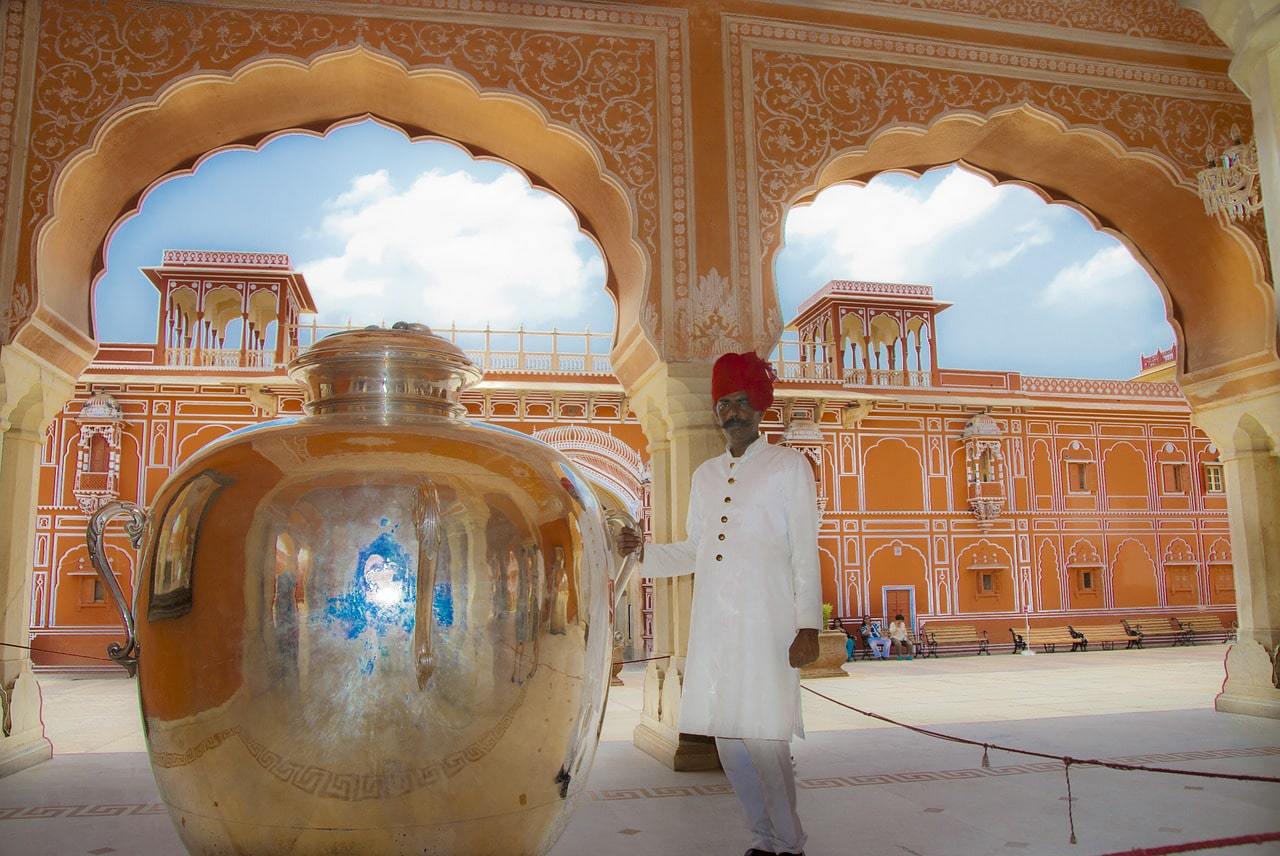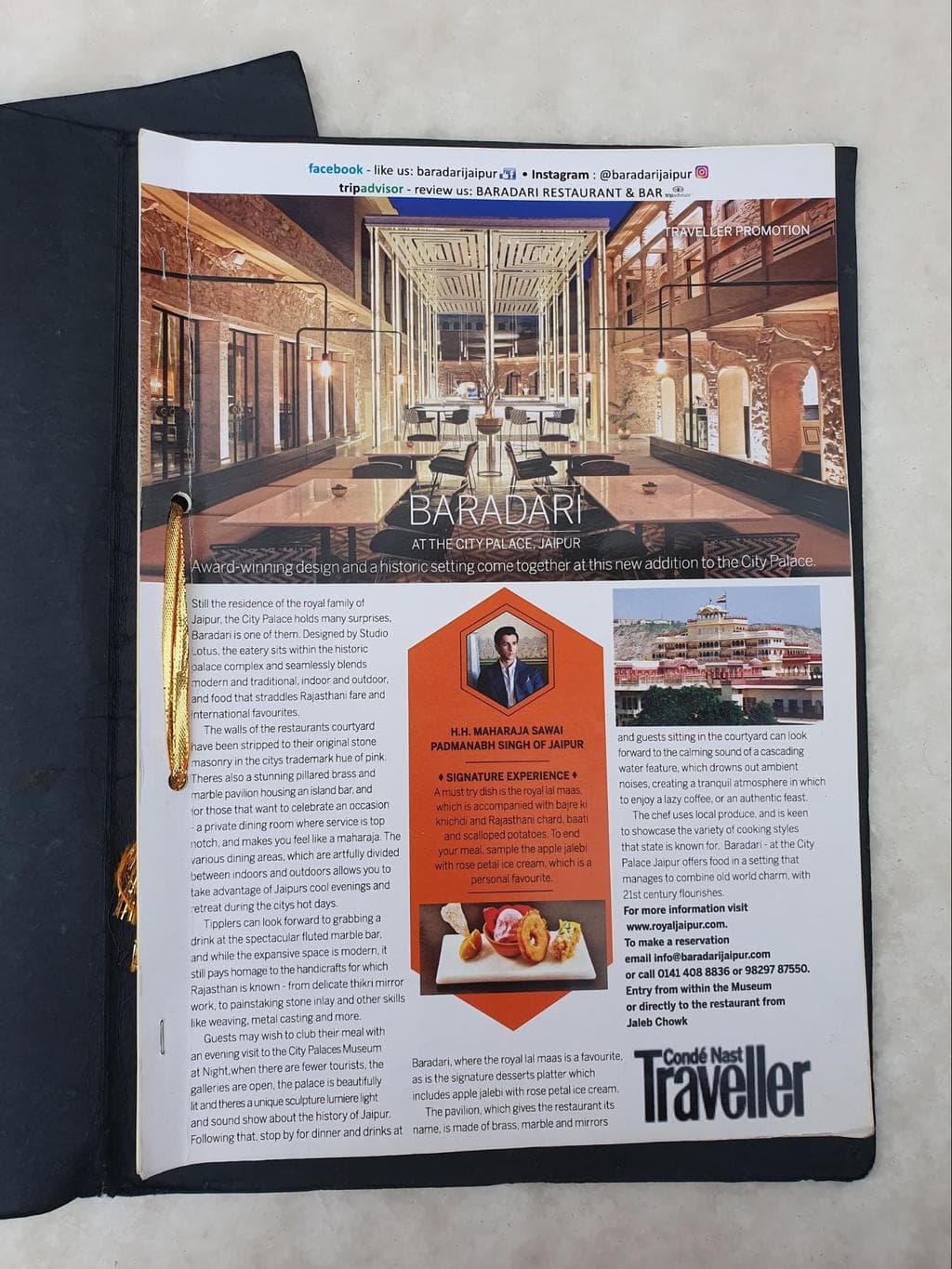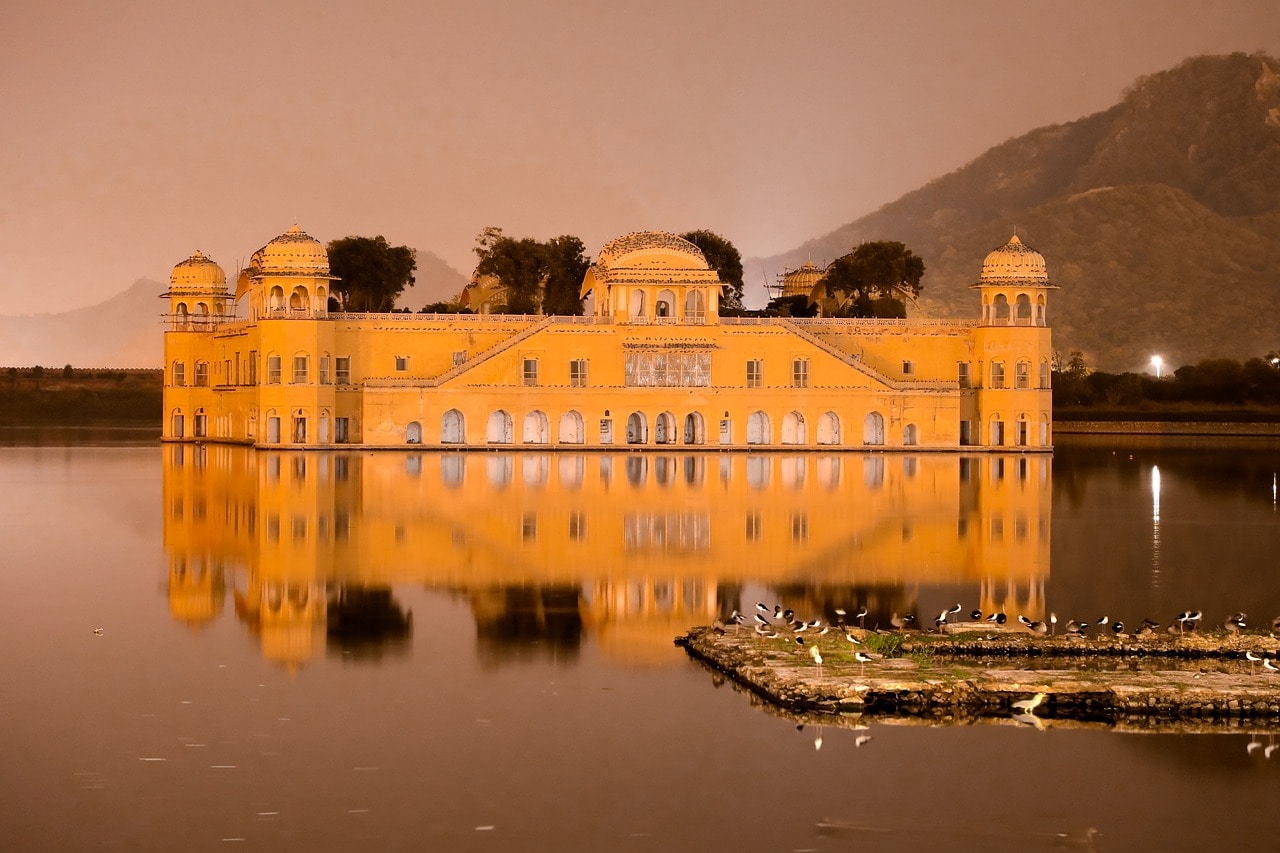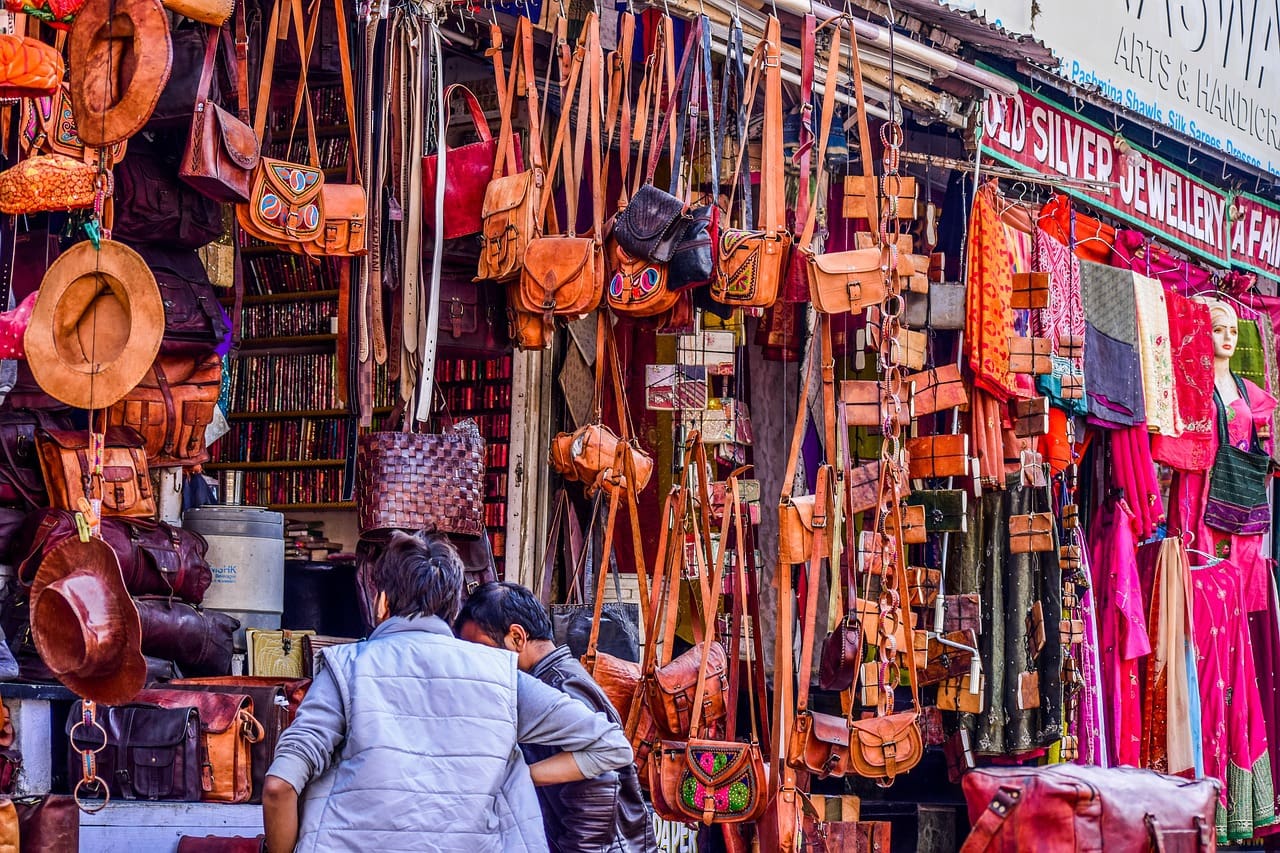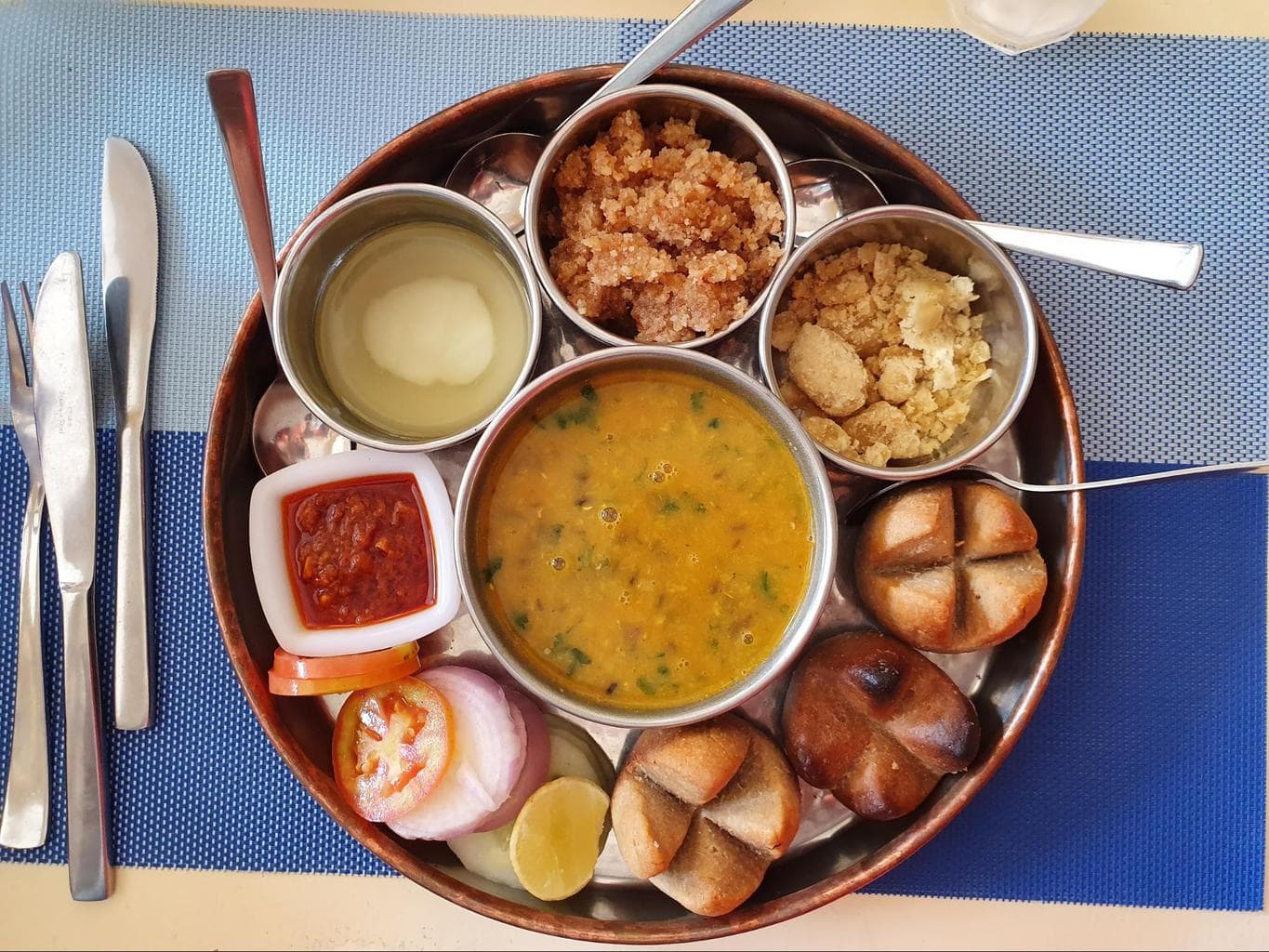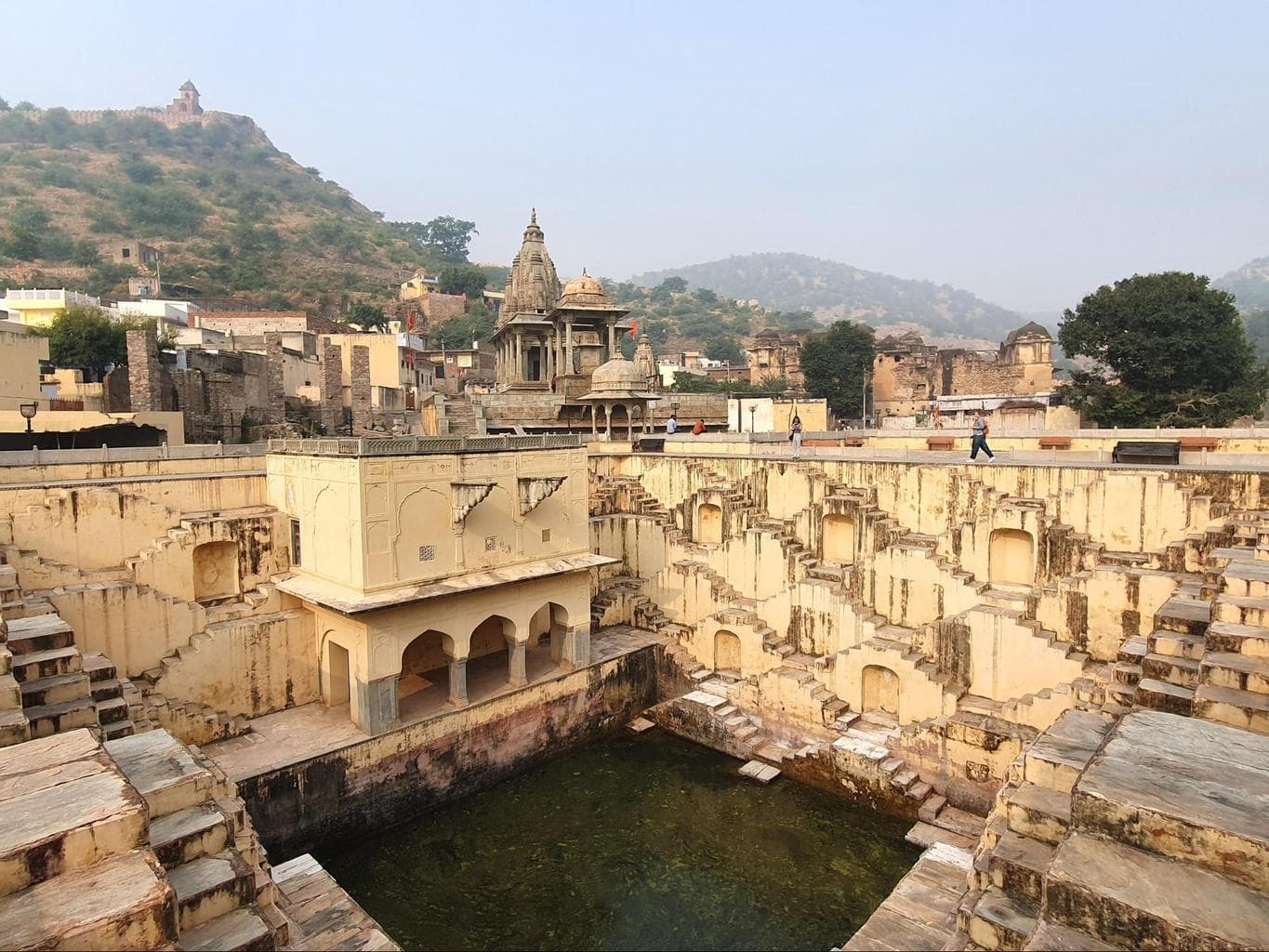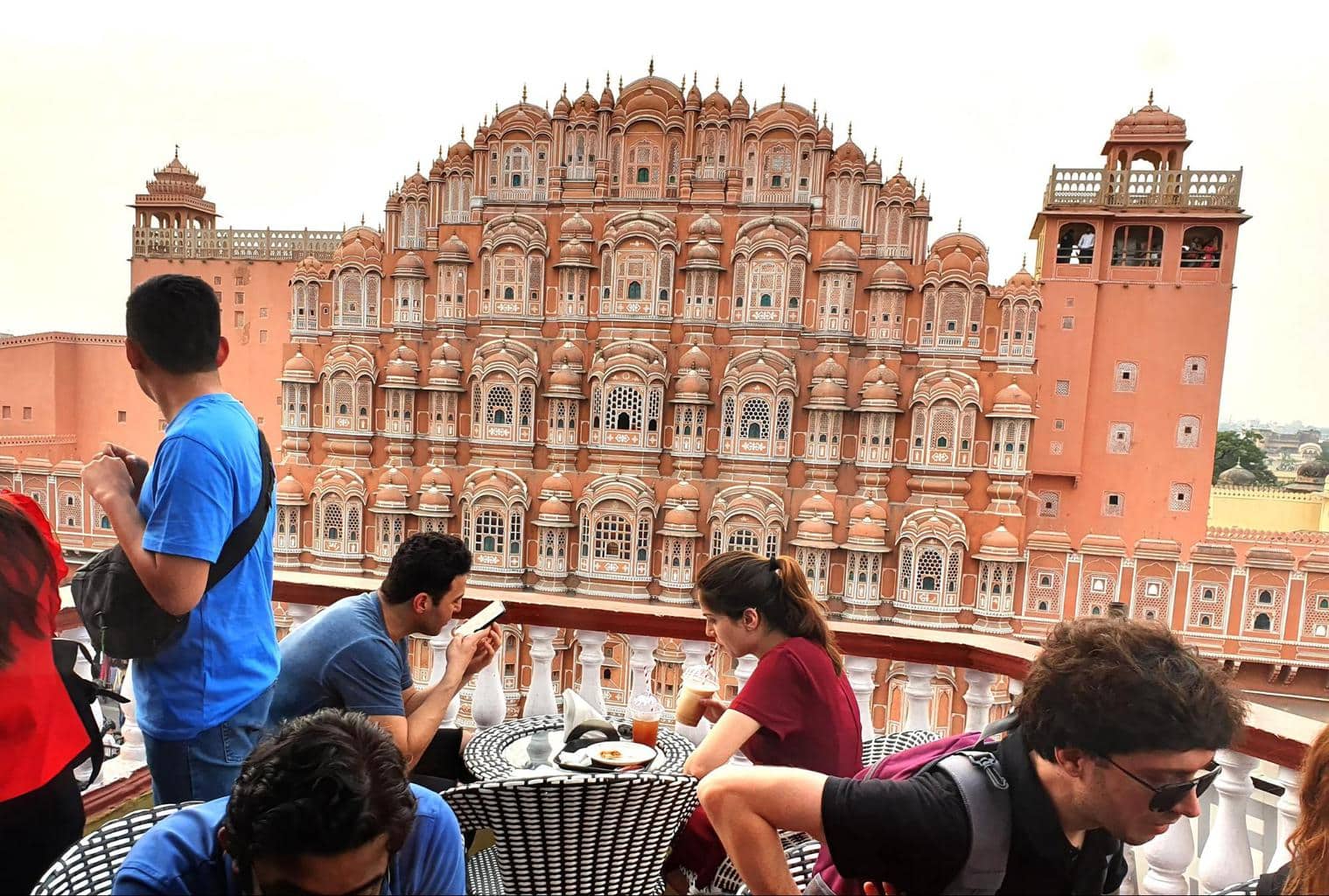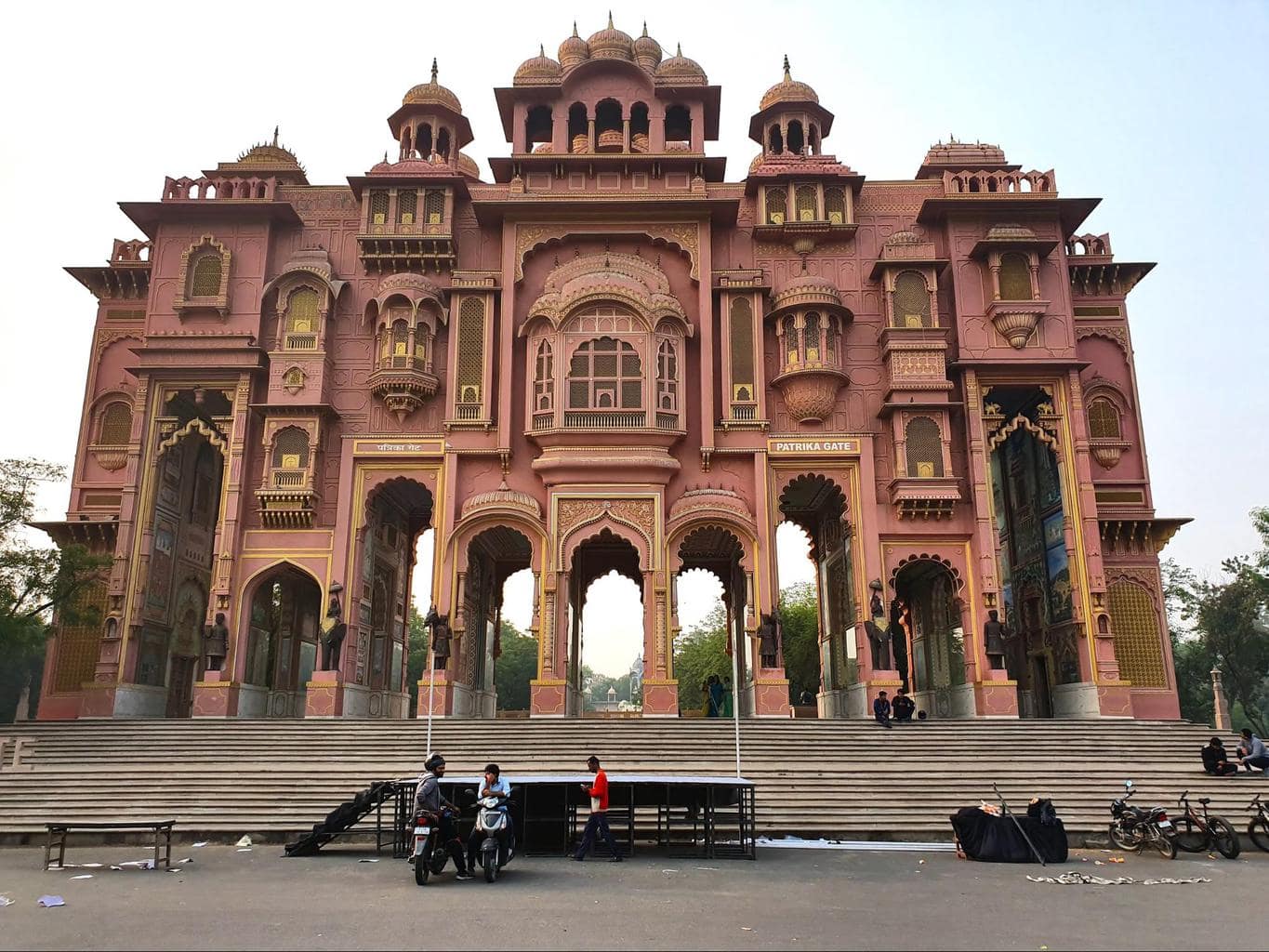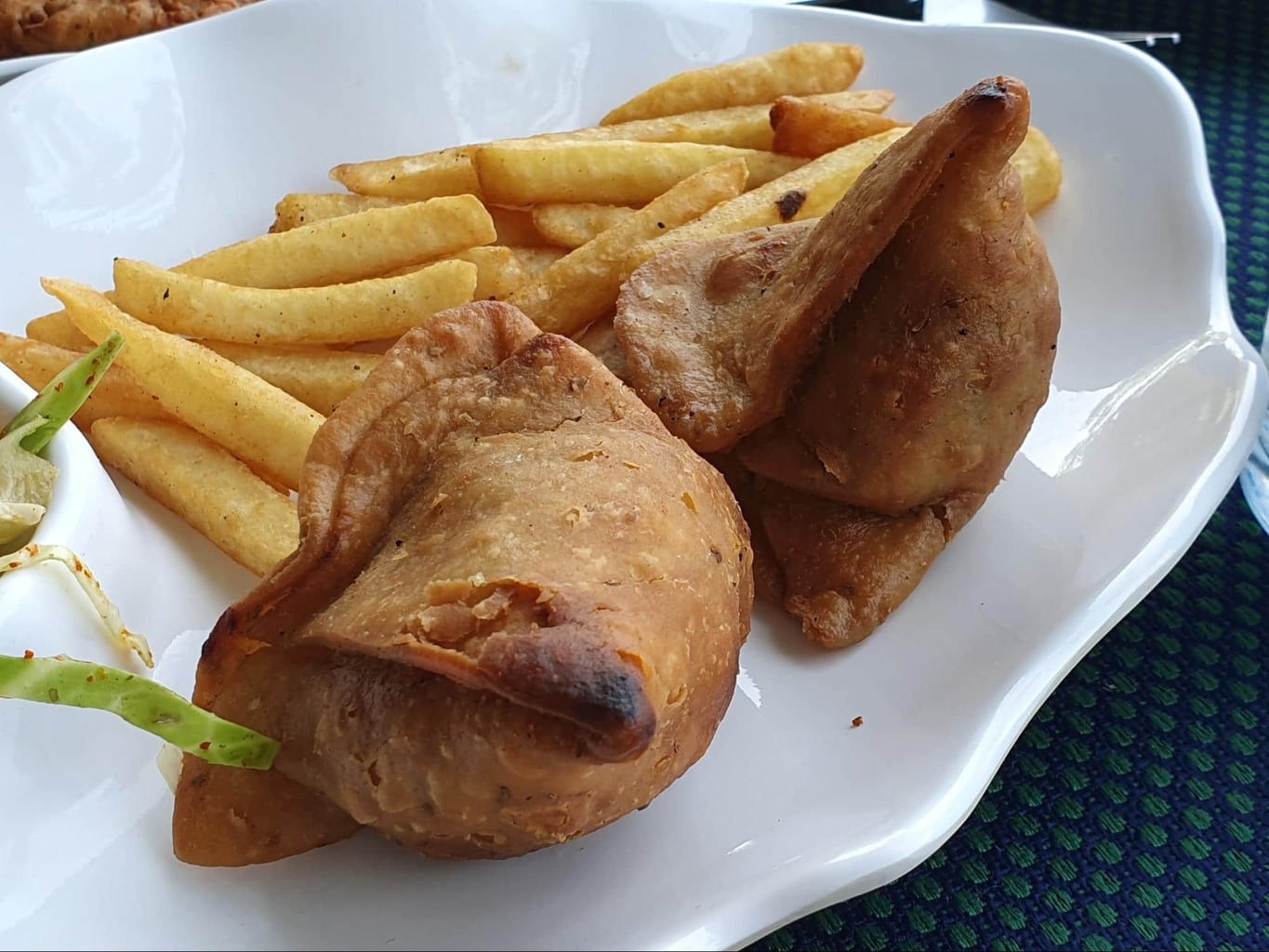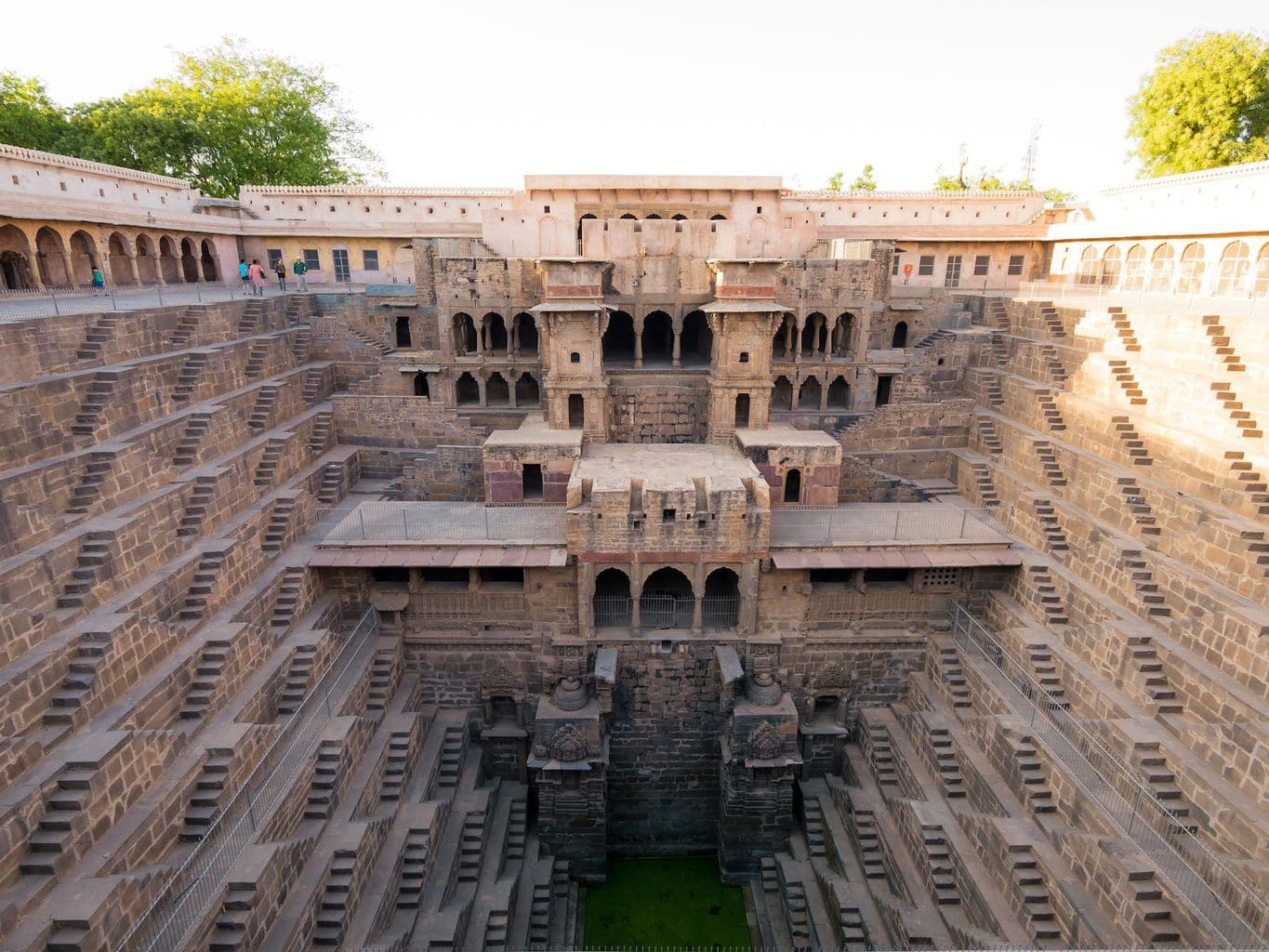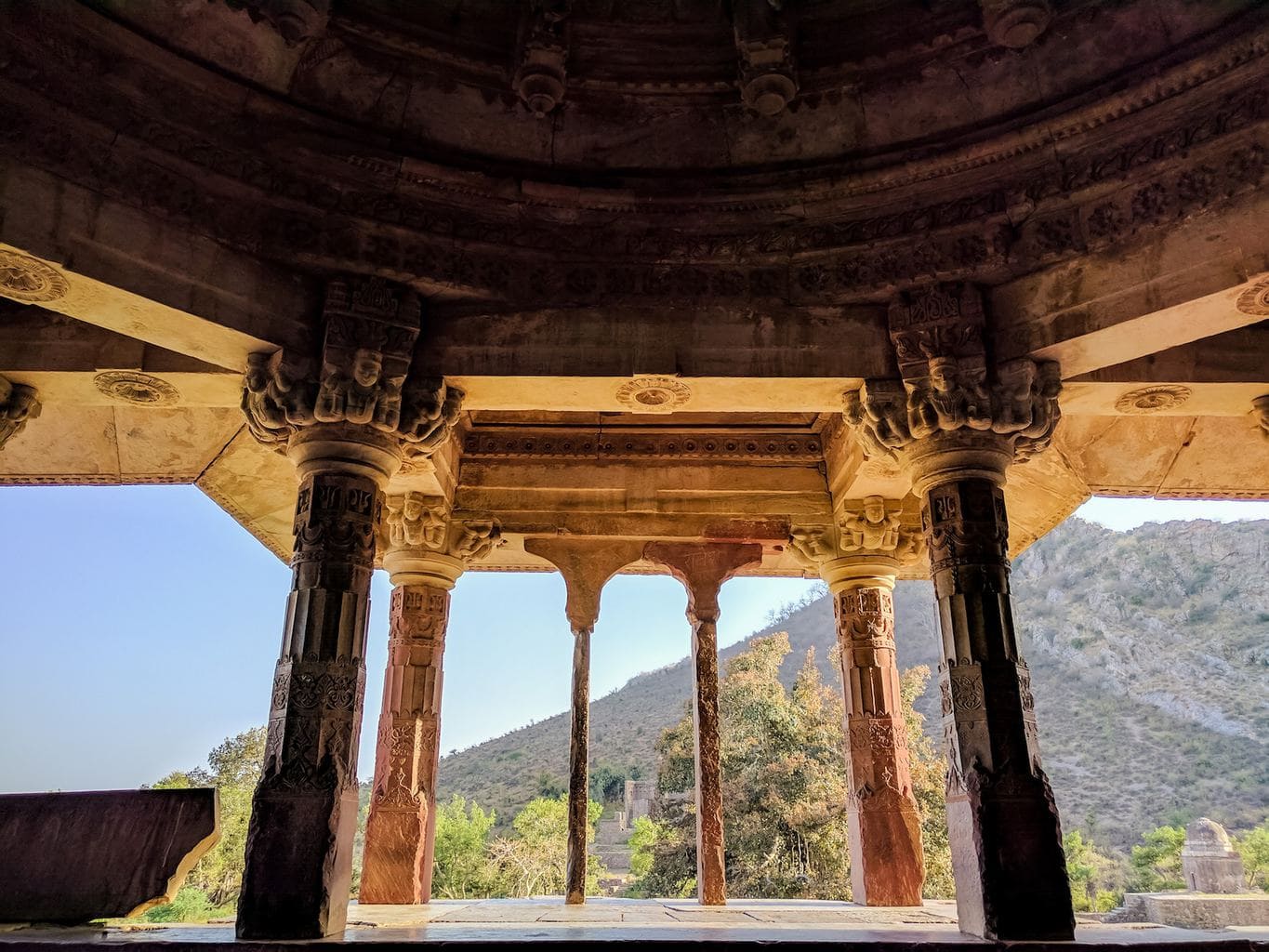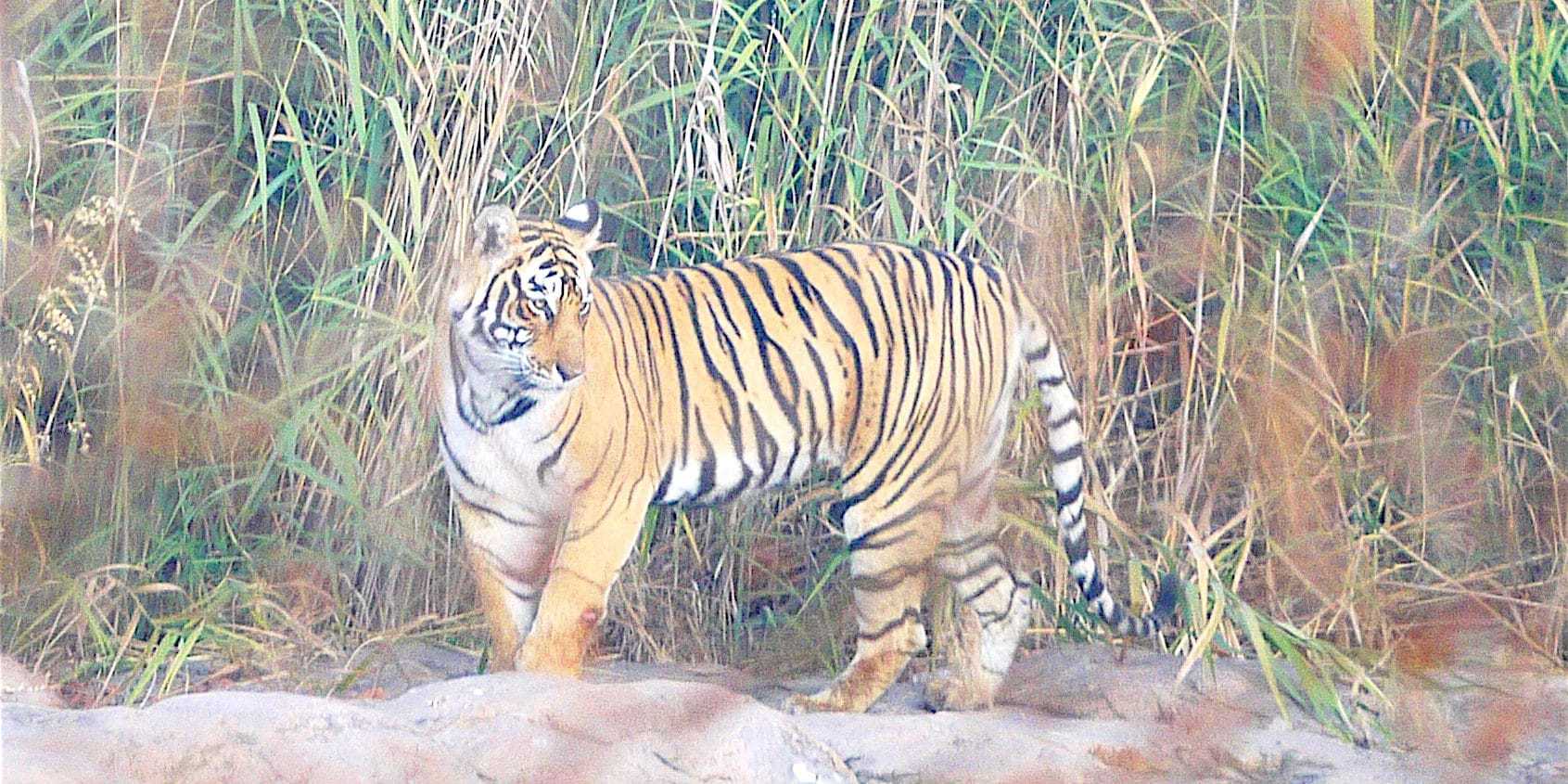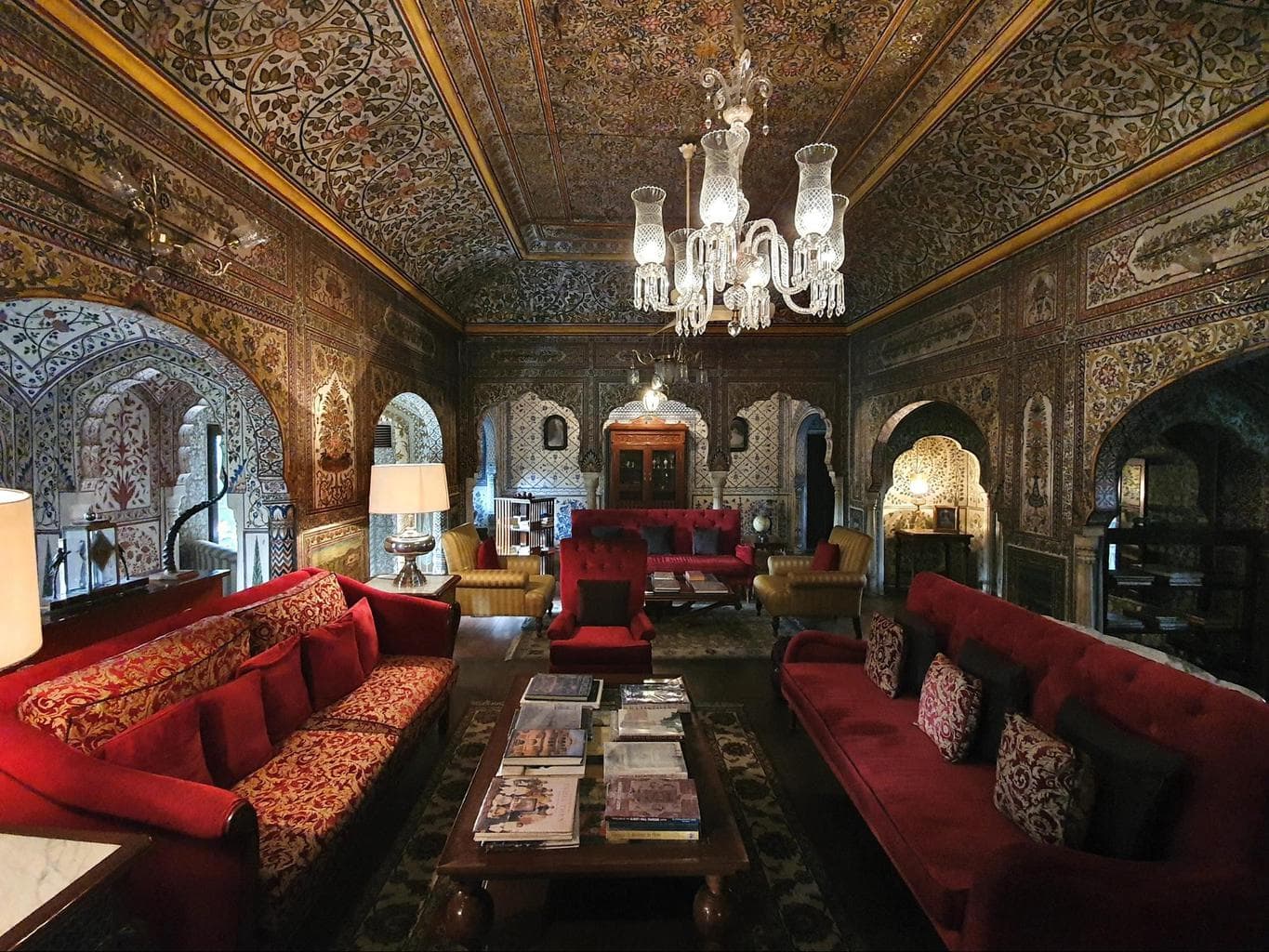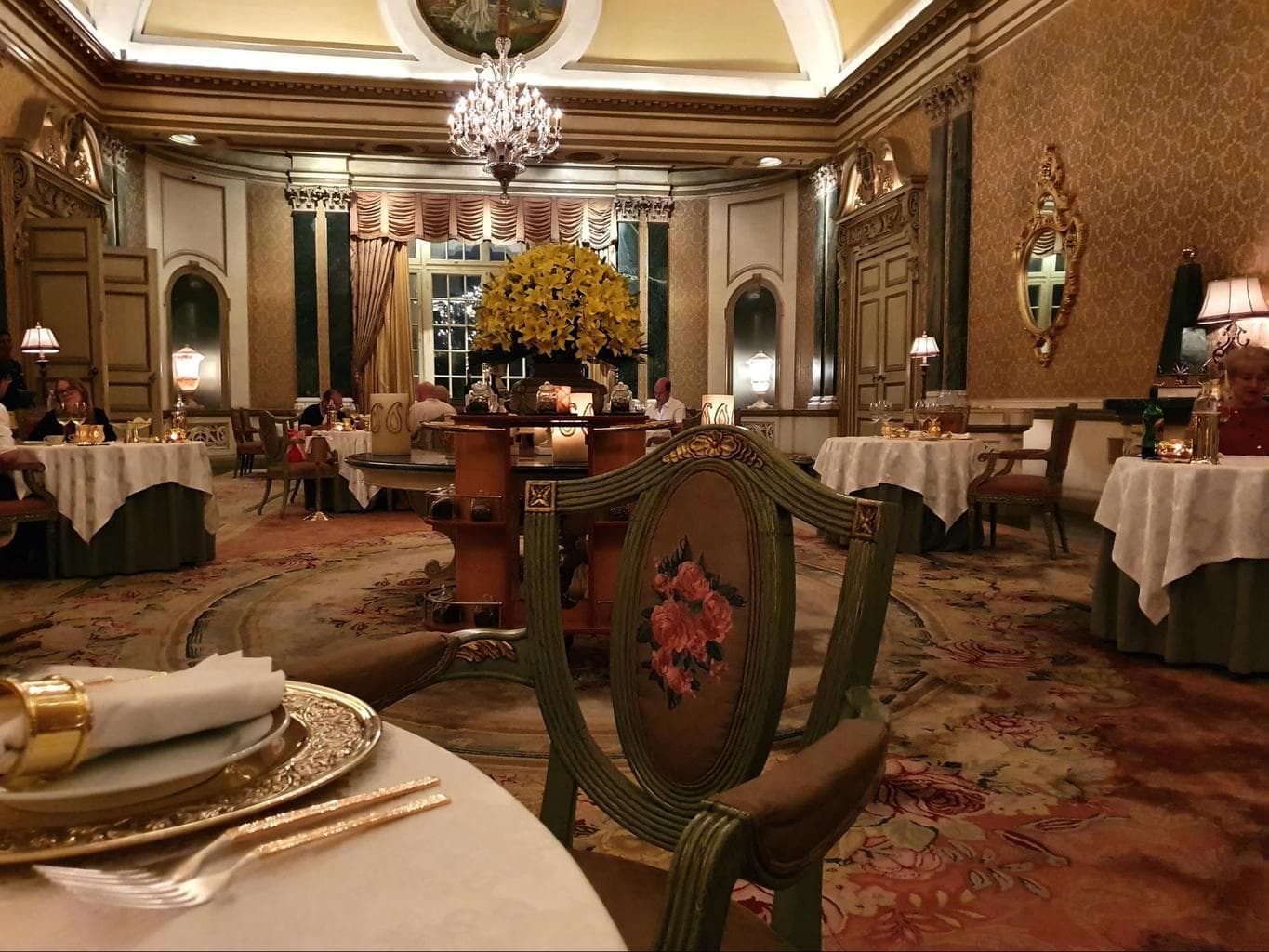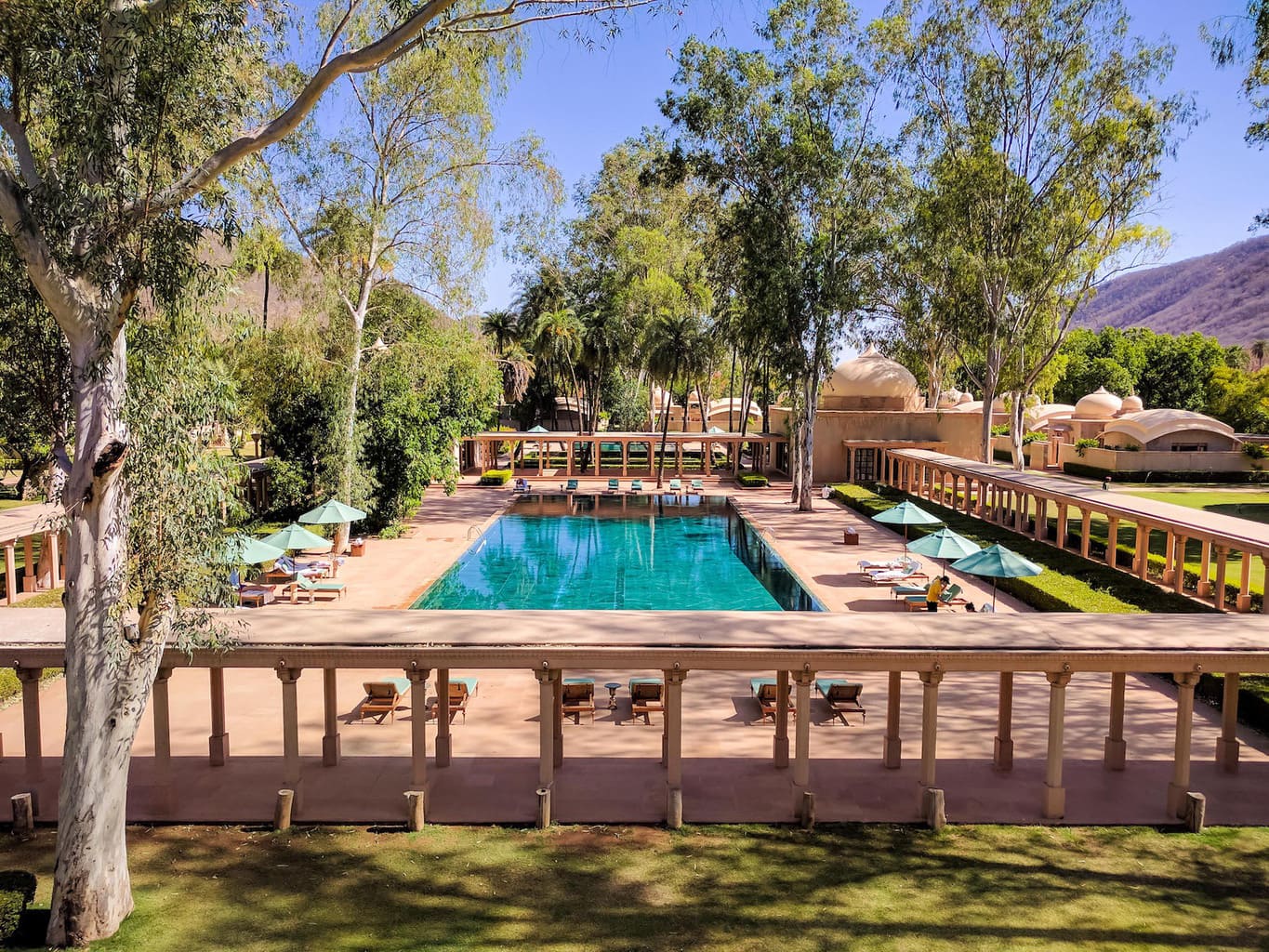Rajasthan’s Pink City is the region’s capital and also the most popular for foreigners to visit. And with reason. With so many UNESCO sites and historical landmarks, there are a lot of things to do in Jaipur to justify a stop.
Like with color palette nicknames of the major cities in Rajasthan, Jaipur is known as the Pink City and the facades of almost all the buildings in the walled city are indeed painted in the exact same pale pink color.
This color, against the arid desert tones of the surroundings, and the perfect symmetry of most buildings, give the city a romantic allure that has been attracting visitors since ancient times.
Many call it a photographer’s dream and the city has recently become an Instagrammer’s magnet.
Today, Jaipur is a must-see stop on the Golden Triangle tours that start in Delhi and continue to Agra and Jaipur. This is why this is the most visited of the Rajasthani cities and receives the most tourists.
It is also the gateway to Rajasthan and the start or ending point for most visitors who then continue onwards to Jodhpur, Udaipur or Jaisalmer. According to Euromonitor, Jaipur is the 39th most visited city worldwide.
As soon as you leave the city and venture into the desert, you will immediately encounter rural life and will escape the tourist buses of the city center.
In this article, we will explore the best things to do in Jaipur and look at some full-day or half-day trips nearby. There is a lot to see around the city and it would be a shame to miss it.
A brief history of Jaipur
Jaipur was founded by Rajput King Jai Singh II of Amer who gave the city his name. As a relatively modern city created from scratch in 1727, it was conceived following urban planning principles in a grid-structure.
Jaipur is commonly known as Rajasthan’s Pink City. This nickname was not original but an addition from the middle of the 19th century when the city wanted to honor the visit from the British Prince of Wales, who later became King Edward VII, by painting the city pink.
Before this facelift, the buildings were painted in the usual pastel yellow and offwhite of most buildings in the region so, to impress the future king, Sawai Ram Singh II decided to paint everything the color of hospitality.
This color complements the Fort’s natural pink stone, and it stuck. The law decrees that they all be repainted in the same Jaipur pink every year following the monsoon rains.
This is no mean feat, the city suffers from extreme weather, sun, wind and sand deterioration and keeping it pristinely painted requires quite a lot of effort.
Since India’s independence in 1947 and the merging of the Rajput states into India in 1949, Jaipur became the capital of Rajasthan. The Maharaja of Jodhpur was promised such an honor, but the city was deemed to close to the Pakistani border.
As the capital, Jaipur also boasts of the largest airport with international flight connections to many cities making it the natural gateway to the region. Good road connections to Delhi and Agra also help bring in a steady flow of tourists.
In recent years the city’s heritage has been recognized with several awards which culminated with the inscription of the Walled City as a UNESCO heritage site in 2019 following the previous inscription of Amer Fort and Jantar Mantar.
When you are exploring Jaipur you can feel the city’s relatively newness in the scheme if Rajasthan, but also the Indian, Mughal, Hindu and Muslim influences it perfectly blends into its architecture.
Things to do in Jaipur
If you are wondering what to do in Jaipur you came to the right place. Not only because you will find lots of great inspiration but also because we have included tips to make the most of your visit.
We will start this list of things to do in Jaipur with the most famous landmarks, the UNESCO-listed places that come to mind to anyone who thinks about Jaipur. We will then explore other lesser-known parts of the city.
And because you can’t leave Jaipur without sampling some of its cuisines or visit some of the palace hotels, we have also included that. A little indulgence never killed anybody.
Go on a full day city tour
How long are you staying in Jaipur?
If you are like the majority of the people who visit the city, you are staying for a day or two, if you are lucky, you might spend three days, but that is rare.
Truth is that Jaipur has quite a lot of things to do, but you can also see the main landmarks in a couple of days, including some of the half or full-day trips to nearby landmarks.
The best way to see it all is by booking a private full-day tour. This tour includes all the main highlights such as:
- The City Palace
- Amer Fort
- Jal Mahal
- Hawa Mahal
- Jantar Mantar
After you got all this out of the way in your day tour, you can use the next day for a hot air balloon, the monkey temple, a tiger safari, Abhaneri stepwell or the other forts mentioned here.
I highly recommend booking a day tour so you have it all organized with a driver and guide.
Amer Fort
Amer Fort, also called Amber Fort, is Jaipur’s Jewel in the crown. This UNESCO-listed fort, along with another five in Rajasthan, is the first place of visit on your list of things to do in Jaipur and as soon as you arrive you will immediately understand why.
The fort is located about 11km from Jaipur city center on a hill, as expected from a defensive structure, and is made of four levels, each interconnected to the one below by stairs.
The fort was built in the 16th and 17th centuries, over the ruins of a previous fort, by Raja Man Singh and finished by Jai Singh II, who gave his name to Jaipur. However, the fort was expanded and renovated further during the following two centuries.
Amer Fort was the capital of Amer until the 18th century when it moved to Jaipur. The Maharajas who ruled this part of Rajasthan belonged to the Kachwahas group and formed strong alliances with the Mughal Emperor Akbar.
Raja Man Singh fought many battles for Akbar as a commander of an army of 7,000 and was considered a son by the Mughal Emperor. He even fought against Pratap Singh, King of Mewar, whose father founded Udaipur.
Amer Fort’s architectural appeal starts with the materials used. The structure was built in pink stone and white marble and no expense was spared to make it an opulent and over the top construction.
The facades display intricate designs and murals and the amount of white marble used is just breathtaking.
The courtyards and squares here are more beautifully decorated than in any other palace or fort in Rajasthan, especially from outside. Instead of the stone carvings of Jodhpur or Jaisalmer, you have paintings and murals.
The fort has four courtyards. The Hall of Public Audience (Diwan i Aam), the Hall of Private Audience (Diwan i Khas), the stunning Mirror Palace (Sheesh Mahal) and the Hall of Pleasure (Sukh Niwas) where a system of waterfalls and windows created a cool breeze the royals could enjoy while swaying on swings.
Each of these is an individual work of art and would make worthy visits, together, they create one of India’s most remarkable example of Rajput architecture.
Once you cross the first gate dedicated to the Sun God, you will enter an expansive courtyard that was used to hold military parades after victories, the size of this courtyard explains its use.
From this courtyard, you have views over Lake Maota below, the hills around it and the city walls. Nahargarh Fort is also visible from here.
Go up the stairs and you will find a small temple built after the Maharaja defeated the Raja of today’s Bangladesh, this is the temple used by the royal family to worship.
Next is Ganesh Gate, a turquoise and beige gate with stunning frescoes from the 17th century that are pretty well preserved. This gates makes for some incredible photos, if you manage to fight through the crowds that usually gather.
After Ganesh Gate you will find the raised pillared Hall of Public Audience, where the king would hear the general public with their needs and demands.
This beautiful pale pink, double-column courtyard sits in the middle of a large courtyard that is flanked by shops, a small museum and the entry gates to the rest of the fort and palace.
Cross another Ganesh Gate and enter the third courtyard, one which is expansive and green thanks to a garden that is in between the two buildings in this courtyard.
You can explore the various rooms, balconies and structures in this courtyard, most notable are Sheesh Mahal, or the Palace of Mirrors, also known as Jai Mandir. This mirror and glass palace was the private residence of the Maharaja and was built in 1727, the year of Jaipur’s foundation.
You cannot go inside the palace but can observe it from outside. The entire structure is covered in a concave Belgium mirror and painted glass that reflects the light. It is said that the light of candles at night created a magical feeling. When you see it, you are left speechless. You then continue across Rajasthan and realize there is a Sheesh Mahal in Udaipur and in Jodhpur.
Across from Sheesh Mahal, on the other side of a geometrically designed, Mughal-inspired garden, is Shuk Niwas or Palace of Pleasure. This palace is made of white marble and decorated with colorful inlay work similar to the Taj Mahal.
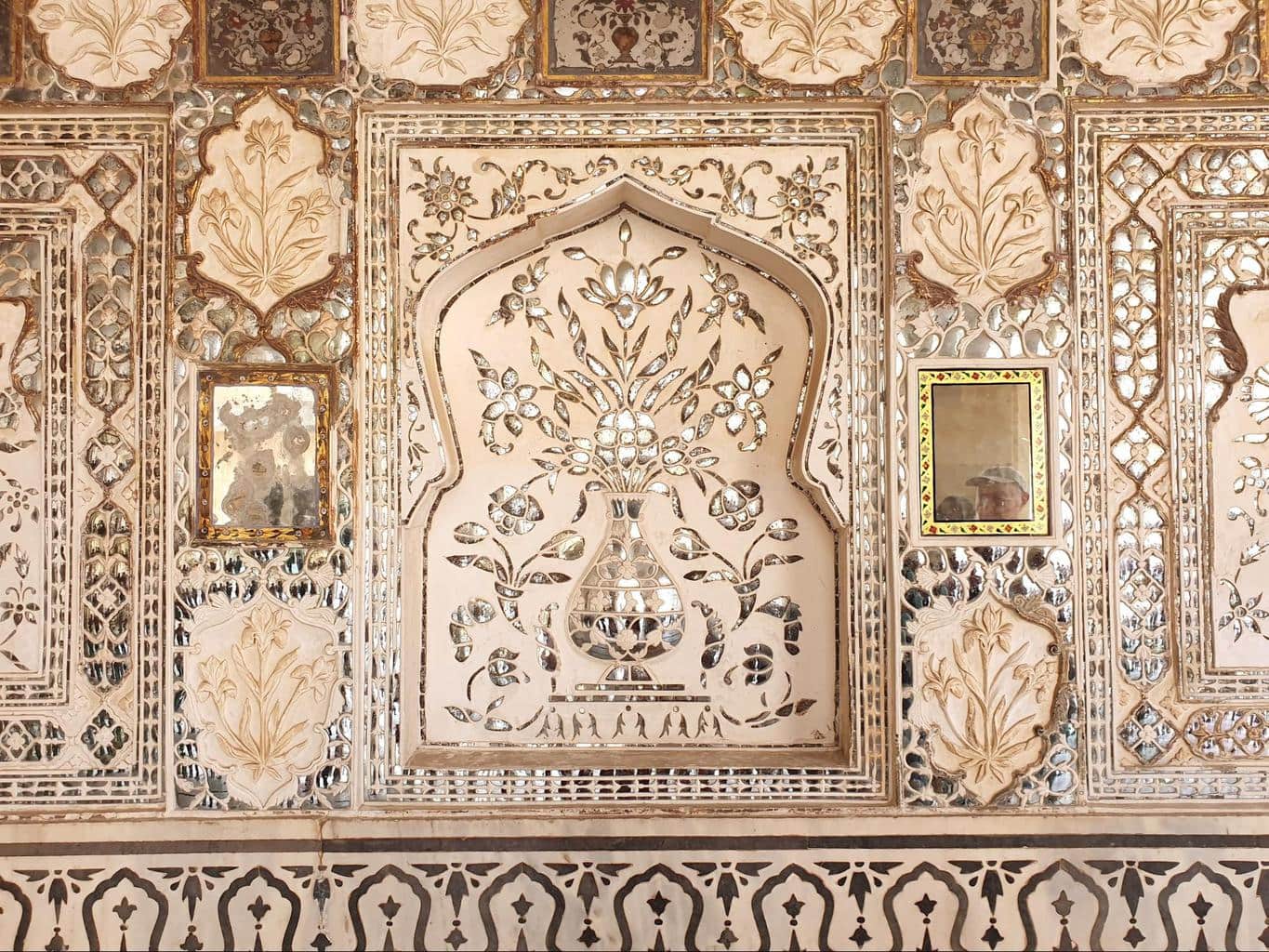
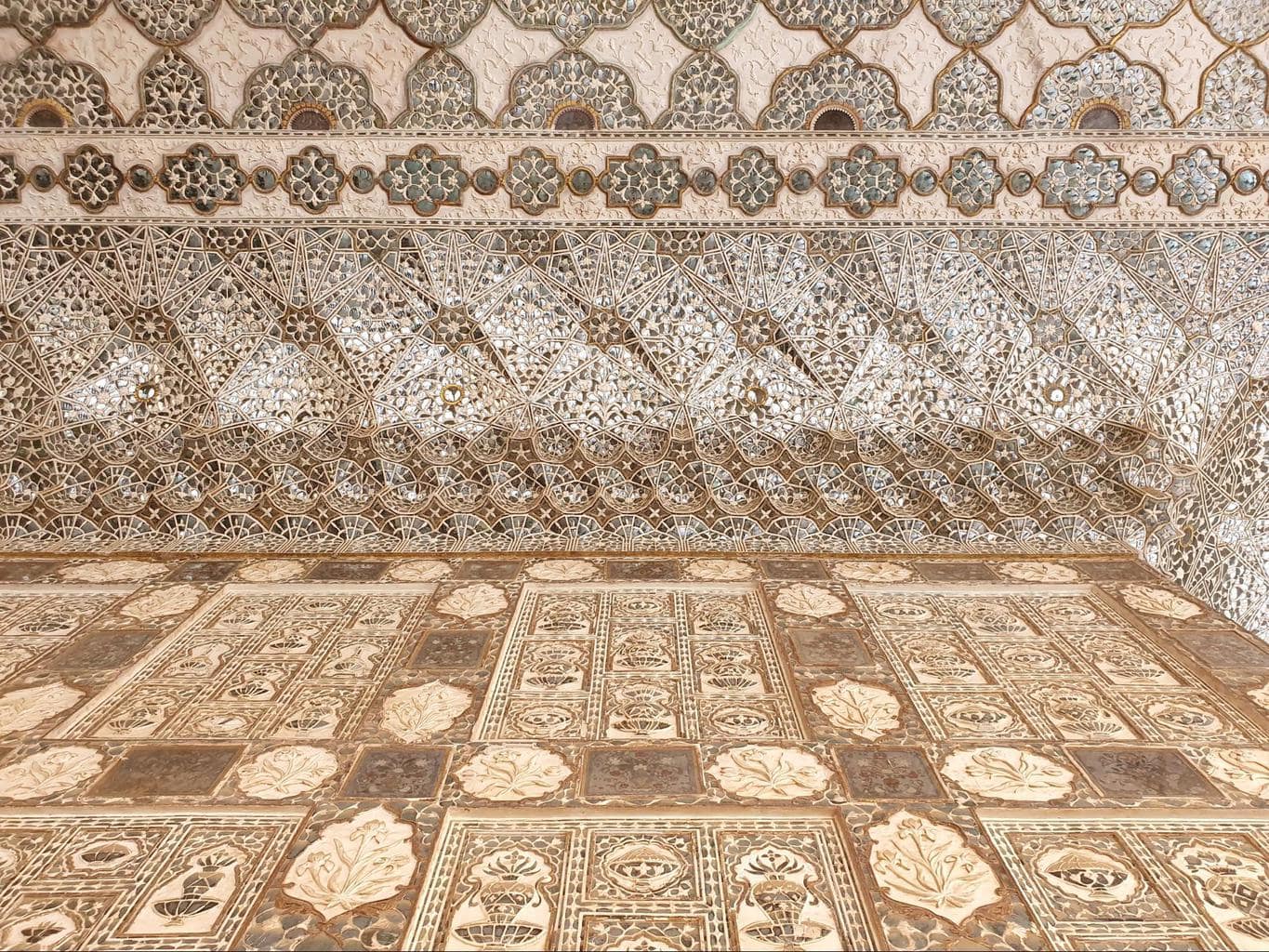
The clever work of engineers of the time created a cool breeze that made the steaming hot summers in arid Jaipur more bearable.
Water poured from nearby lakes and the wind flow created by the wind blew refreshing air onto the members of the royal family who were also fanned by their servants.
Don’t miss the chance to go up to the upper level for a bird’s eye view of the gardens and palaces as well as the area surrounding the fort.
The fourth and last courtyard is Zenana and used to house the Maharaja’s Queens, concubines and mistresses. Here is also the oldest part of the fort, the Palace of Man Singh I. Not as opulent as the rest of the fort, but worth it to understand how royal life happened.
Amer Fort is one of the most photogenic spots in Jaipur and makes for an amazing place to visit in Jaipur if you are an avid photographer. History buffs will also find their passion fulfilled.
More information here.
The best way to visit the Fort and the rest of Jaipur is on a guided tour. Here are the best options:
- If you just want to visit at your own pace and maybe get guides onsite at some of the landmarks, book your combo tickets for the major attractions in Jaipur, it is worth it. Buy the combo ticket here. Ticket includes Hawa Mahal, Amer Fort, Albert Hall, Jantar Mantar.
- Private full-day tour which includes the fort, Jal Mahal, the City palace and lunch with a guide and air-conditioned car. This one includes it all as well as entry tickets.
Amer Fort is accessed via a steep rampart where traffic jams are common, you can walk up or take a 4×4 car, regular cars are not allowed. Another alternative is to ride an elephant up, please don’t do that.
If you need any reasons why this is not the right way to make an entrance, read this article from PETA that will tell you why this is cruel to the animals, if you can, the reality is so gruesome you may not be able to finish reading it. Or this one from World Animal Protection. Just don’t, not in India not in Thailand, not in Cambodia where we saw it at Siem Reap and learned more about elephants in the Wild East, not anywhere.
Amer Fort is a really popular place to see in Jaipur and receives up to 10,000 visitors per day in the peak season, it pays to plan your visit well, especially if you want to take photos.
While most guides and tours will suggest you go in the morning, I would recommend you are either there just as it opens or go in the afternoon, both timings see far fewer tourists.
To make the most of it, go during the day to visit the fort and return at night for the light and sound show which narrates the history of the fort against a projection on its walls.
Jaigarh Fort
This upper fort located just above Amer Fort on the hill of Eagles is connected to Amer Fort by an underground passage.
Its most relevant element is the Jaivanna Canon which was the largest on wheels at the time but was never used in battle. The cannon was fired once and it reached 35km. The canon can be seen on a visit.
The fort was one of Mughal Emperor Shah Jahan’s most important canon manufacturing facilities thanks to the iron mines in the area and a large wind tunnel used to increase the temperatures in the furnace. It was this infrastructure which, later on, was used by Jai Singh to build the Jaivanna Canon.
Jaigarh Fort is a popular photography spot. From here you have panoramic views of Amer Fort below and the distinctive pink walls that make Jaipur famous for the stretch over 3km.
But the fort is worth a visit on its own. It has courtyards, gardens, a lake, a museum and an armory room with weapons on display. The prettiest part of the fort is the garden complex, reminiscent of other Mughal gardens found in Lahore’s Jahangir’s Tomb or Lalbagh Fort in Dhaka.
More information on the official website of the fort.
The fort is best visited after or before Amer Fort as it is nearby. Some parts of the walls are accessible outside of working hours and make for great pictures.
Nahargarh Fort
This fort completes the defensive network of structures around Amer and was named after Nahar Singh whose spirit was said to be blocking the construction of the fort until a temple was built in his honor.
The fort was built in the 18th century by Maharaja Sawai Jai Singh as a summer palace and was later expanded. It is popularly known as the backdrop to some famous Indian movies such as Rang de Basanti.
When you visit the fort you also have the chance of visiting the Jaipur Wax Museum.
The fort is best visited after or before Amer Fort as it is nearby. You can also buy tickets ahead of time here. This combo ticket includes Hawa Mahal, Amer Fort, Albert Hall, Jantar Mantar and Nahargarh Fort.
Jantar Mantar
This UNESCO-listed attraction in Jaipur is an astronomy center built by Maharaja Sawai Jai Singh II in the first half of the 18th century along with four other observatories in India, specifically in Delhi, Varanasi, Mattura and Ujjain.
Jai Singh took inspiration from other constructions and from Islamic texts but built something completely unique based in his Hindu upbringing. Hindu religion relies on astronomy for its teachings and used an astrolabe to tell the movement of stars.
As you tour the constructions, which look nothing like astronomical devices but more like sculptures, you can tell the time to varying degrees of accuracy.
Some of the constructions can tell time to the minute, others to the second, some are for summertime and others for winter. Visiting Jantan Mantar is a fascinating thing to do in Jaipur as you admire its ingenuity.
Jai Singh wanted to build time-telling instruments that would be permanent and be unaffected by the passing of time. He noticed that astrolabes used in the past would lose accuracy as their elements were submitted to wear and tear.
Little did he know in the 18th century that we would all carry wristwatches or even mobile phones.
Jantan Mantar has seven structures. The most complex is Jai Prakash inspired by Greek astronomy and a complimentary replica of Delhi’s Rama Yantra. This bowl-like sundial tells time through a metal plate suspended from a metal wire.
In order to increase their time-telling accuracy, the structures had to be larger and larger, the largest is Samrat Yantra which can provide time to two seconds, a never-seen-before level of accuracy.
More information on the official website here.
You can visit Jantan Mantar independently and there are a few signs telling the story of some of the instruments. However, I highly recommend a guided tour to fully grasp the importance of the site. Try this option:
- If you just want to visit at your own pace and maybe get guides onsite at some of the landmarks, book your combo tickets for the major attractions in Jaipur, it is worth it. Buy the combo ticket here. Ticket includes Hawa Mahal, Amer Fort, Albert Hall, Jantar Mantar and Nahargarh Fort.
Jantar Mantar is walking distance from Jaipur’s City Palace so you should combine the visit. There is absolutely no shade in the entire complex, as the instruments work with sunlight, so bring a hat and wear sunscreen.
Jaipur City Palace
After the packed Amer Fort, you will welcome the peace of some parts of the City Palace.
How come, you may wonder? Because there is the option to purchase a premium entry ticket that gives access to the Maharaja’s private residence and its high price makes it a difficult-to-justify addition to the best things to do in Jaipur.
However, I strongly recommend you purchase this ticket because this was a highlight of my time in Jaipur. Not to mention the great photos you will be able to take, minus the crowds. In the close to 2h we were there, we saw no more than 5 other visitors.
Built by Maharaja Sawai Jai Singh II in 1727, at the same as he moved his seat of power to the fort, Jaipur City Palace was his official residence until India’s independence in 1949 and today hosts a museum.
The City Palace is at the center of today’s Jaipur. The palace was built when Amer Fort and Amer City became too small for the population and water started to be a problem.
Because the city was built from scratch, there was a degree of urban planning involved and the streets follow a grid system that makes it easier to navigate, although the cows, scooters, rickshaws and camel carts don’t help.
There are two main entrances to the City Palace, Udai Pol directly takes you to the ticket office and the Maharaja’s restaurant (highly recommend it, see next section), whereas Virendra Pol is near Jantar Mantar (which is why the two should be visited together).
As soon as you walk into the palace you will find Sarvato Badra, a beautiful pavilion with arched columns painted in the same pale pink of the city. This is where the Maharaja would hold public hearings with his counselors and advisors, which is why it is also referred to as Diwan i Aam.
Look out for two large silver urns called Gangajalis. They were made for Maharaja Madho Singh to bring water from the Ganges for his trip to England to see the coronation of King Edward VII.
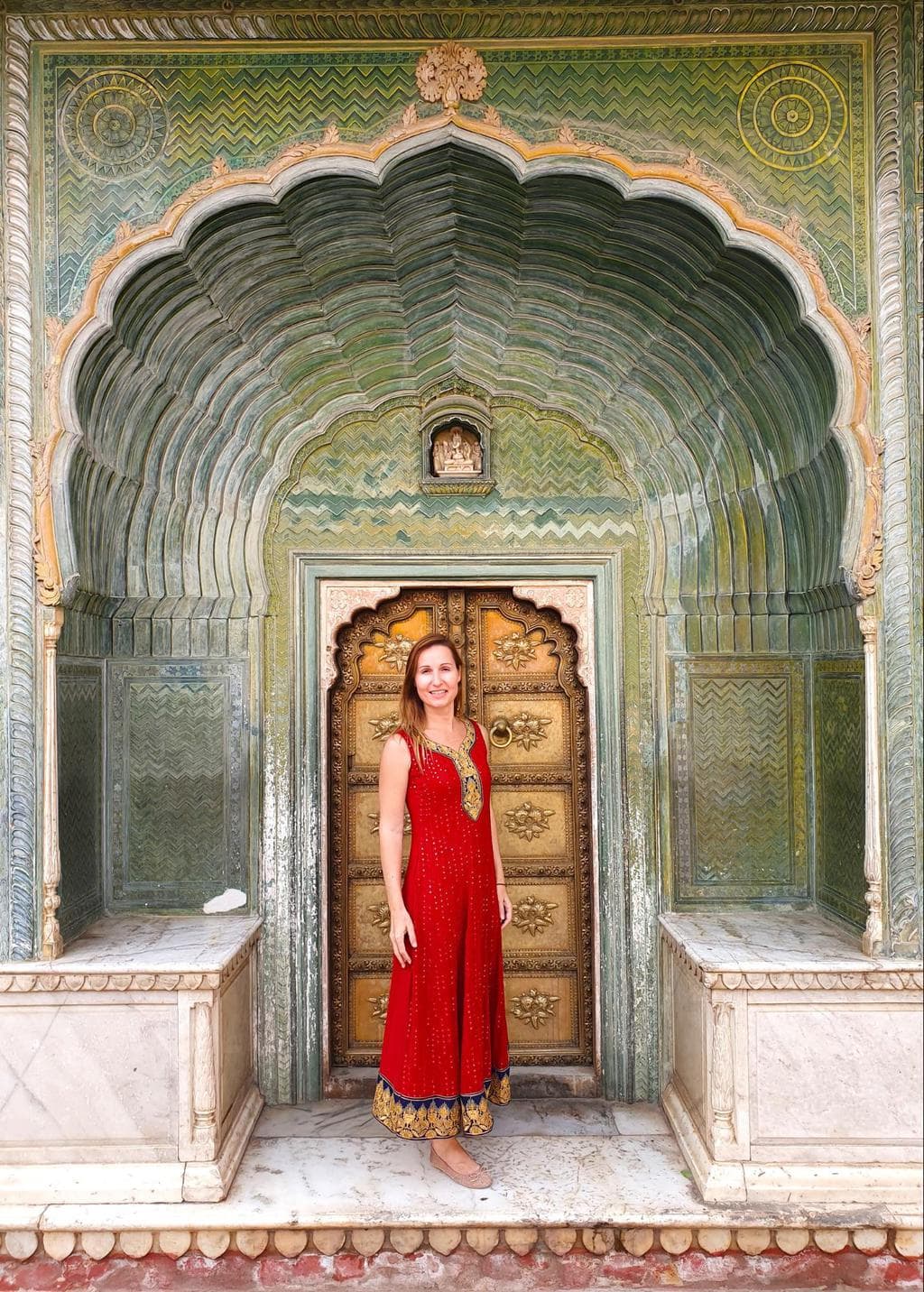
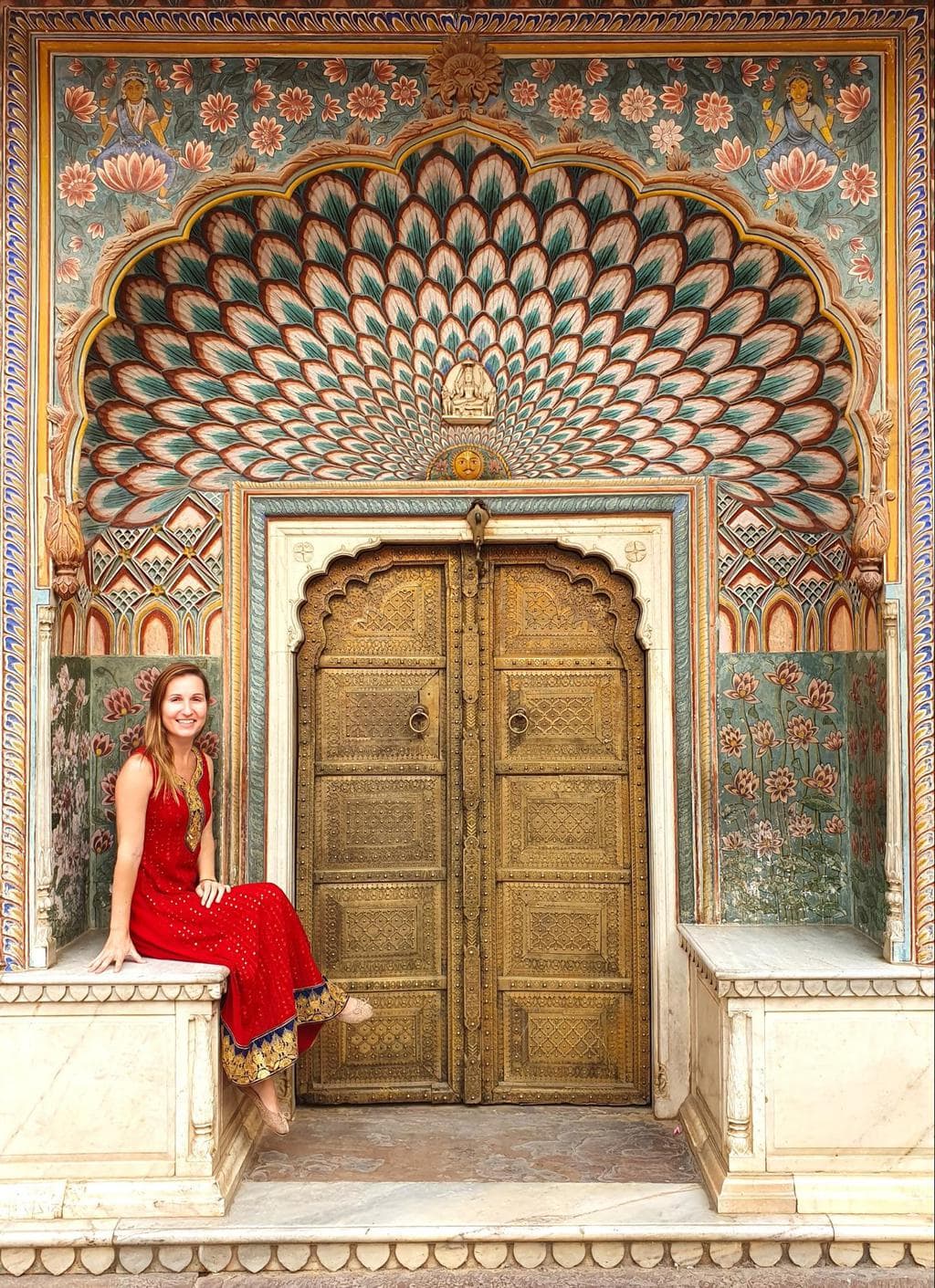
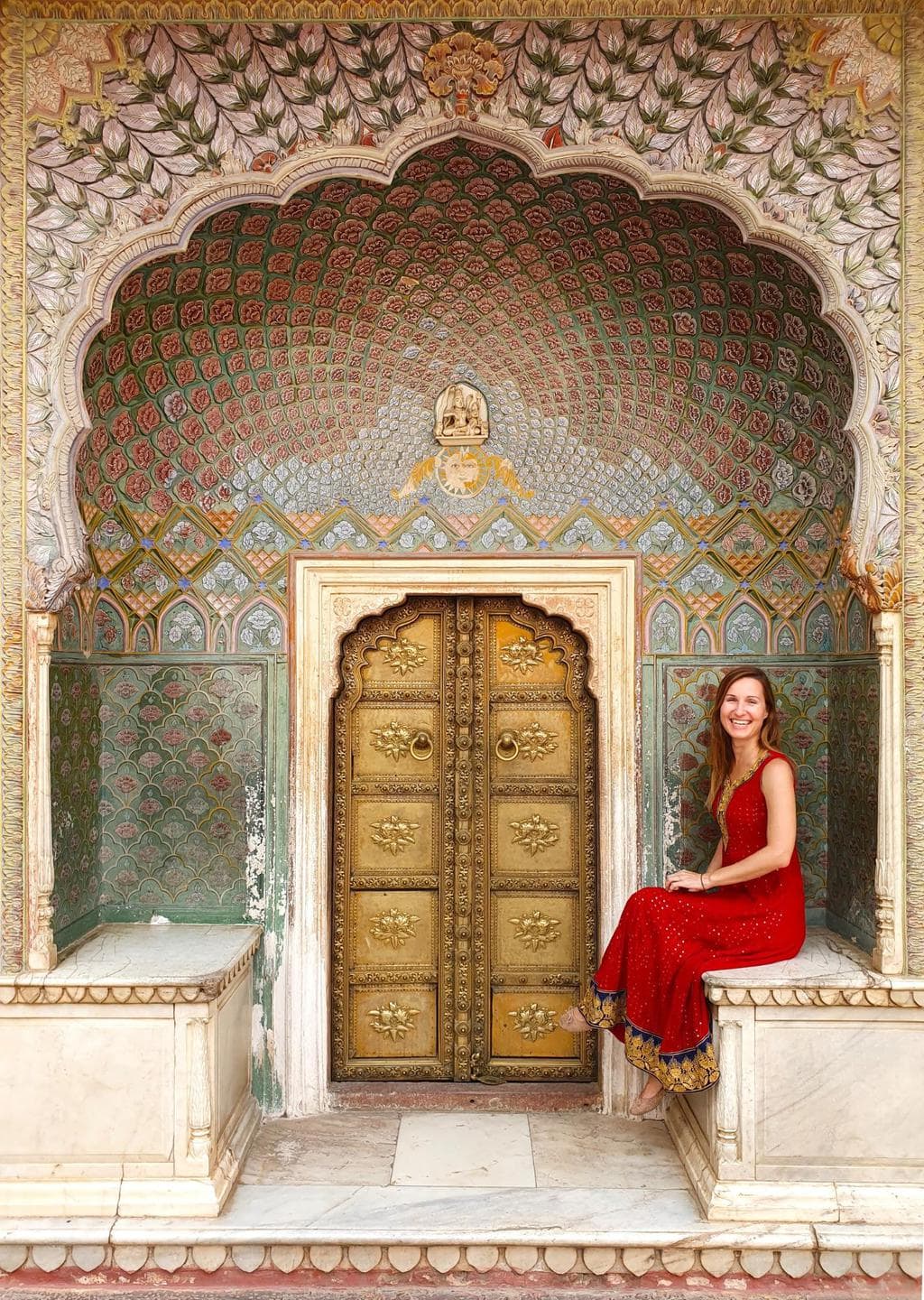
You can then enter Chandra Mahal, but you will only be able to visit the lower level courtyard as the rest of the floors are part of the premium tickets only.
Chandra Mahal’s pink facade is as pretty as the rest of the palace, with white stucco edges and symmetrical windows. Inside, you will find an interior courtyard flanked by four beautiful gates.
It is said that each of them was used by the Maharaja in each of the seasons. They are all designed in a different color but they are all intricate and make for great photo backgrounds, especially the peacock one.
You will even find locals dressed in traditional Rajasthani outfits ready to pose with you (for a fee).
The premium tickets will give you access to the private parts of Chandra Mahal, aka the upper levels, which are the most impressive. You access them from a separate gate from Diwan i Aam that is guarded by a keeper and two cannons.
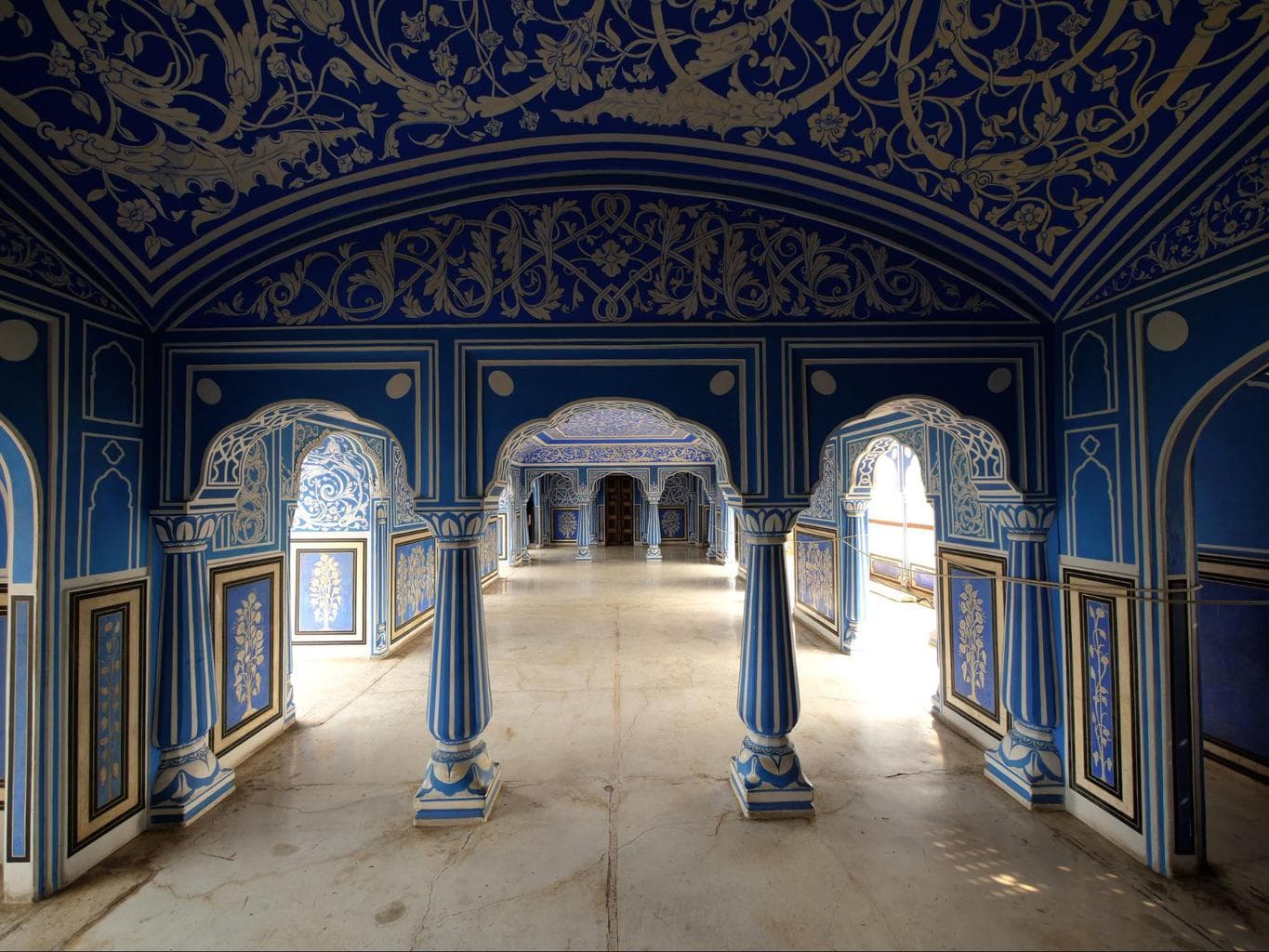
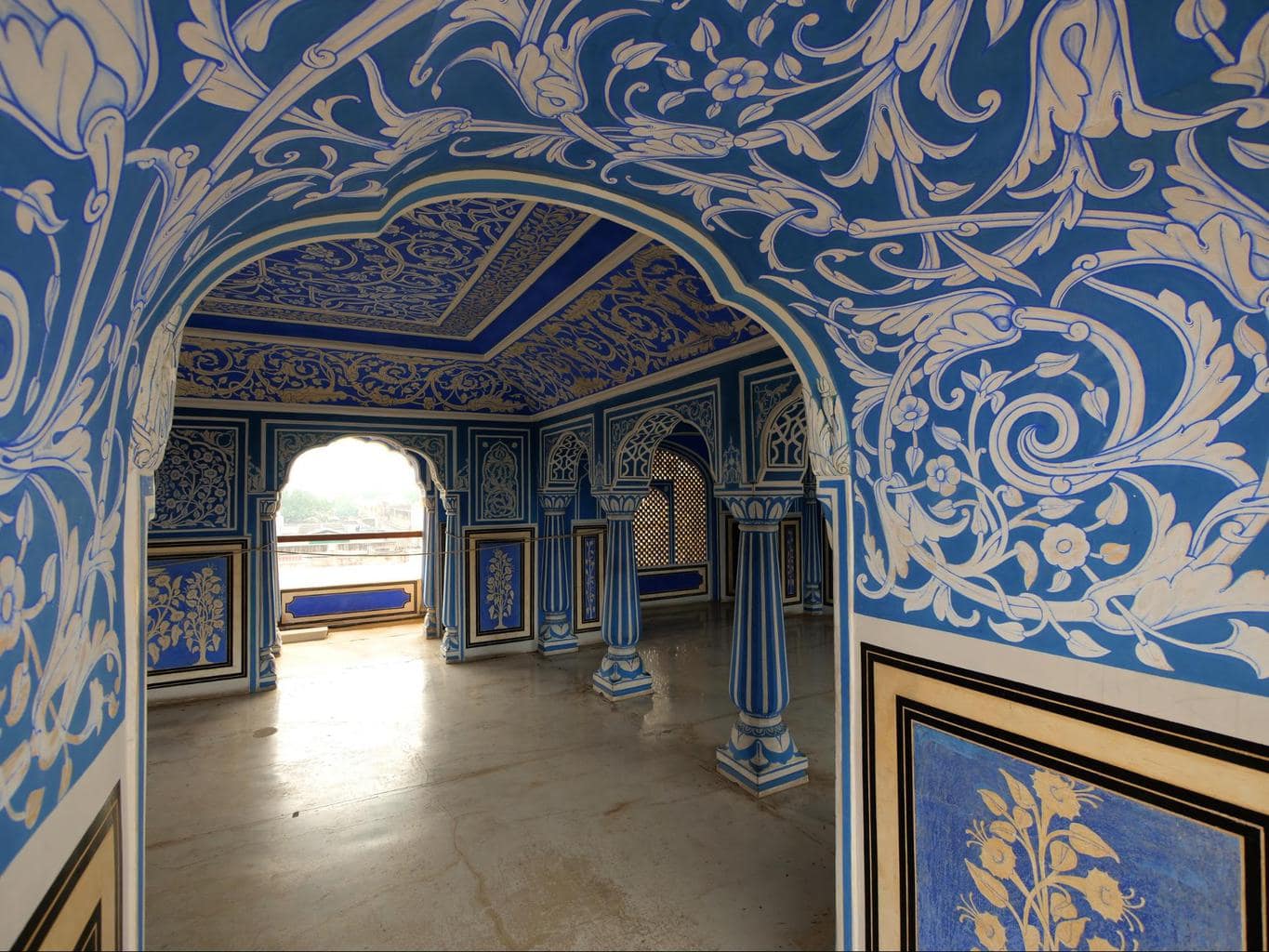
Immediately, you will walk into a corridor where impressive paintings from the Royal family hang on the wall and face the Palace Gardens.
It is in this space that, years before, I had lunch while onboard the Maharajas Express luxury train and watched a game of elephant polo (the sport is now banned, thankfully). You are not allowed to take pictures here.
You then walk into the building and take an old elevator to the upper levels of the palace, there are seven. From there, you explore three main rooms.
Sri Niwas is a palace of mirrors, similar to the ones found in other palaces, and it’s a pretty impressive room. The guard here is well trained in taking pictures and will offer to take some cool version of your reflection on the mirror or group photos with your travel companions.
Ask him to turn off the lights and turn on specifically placed color lights, the effect is quite something.
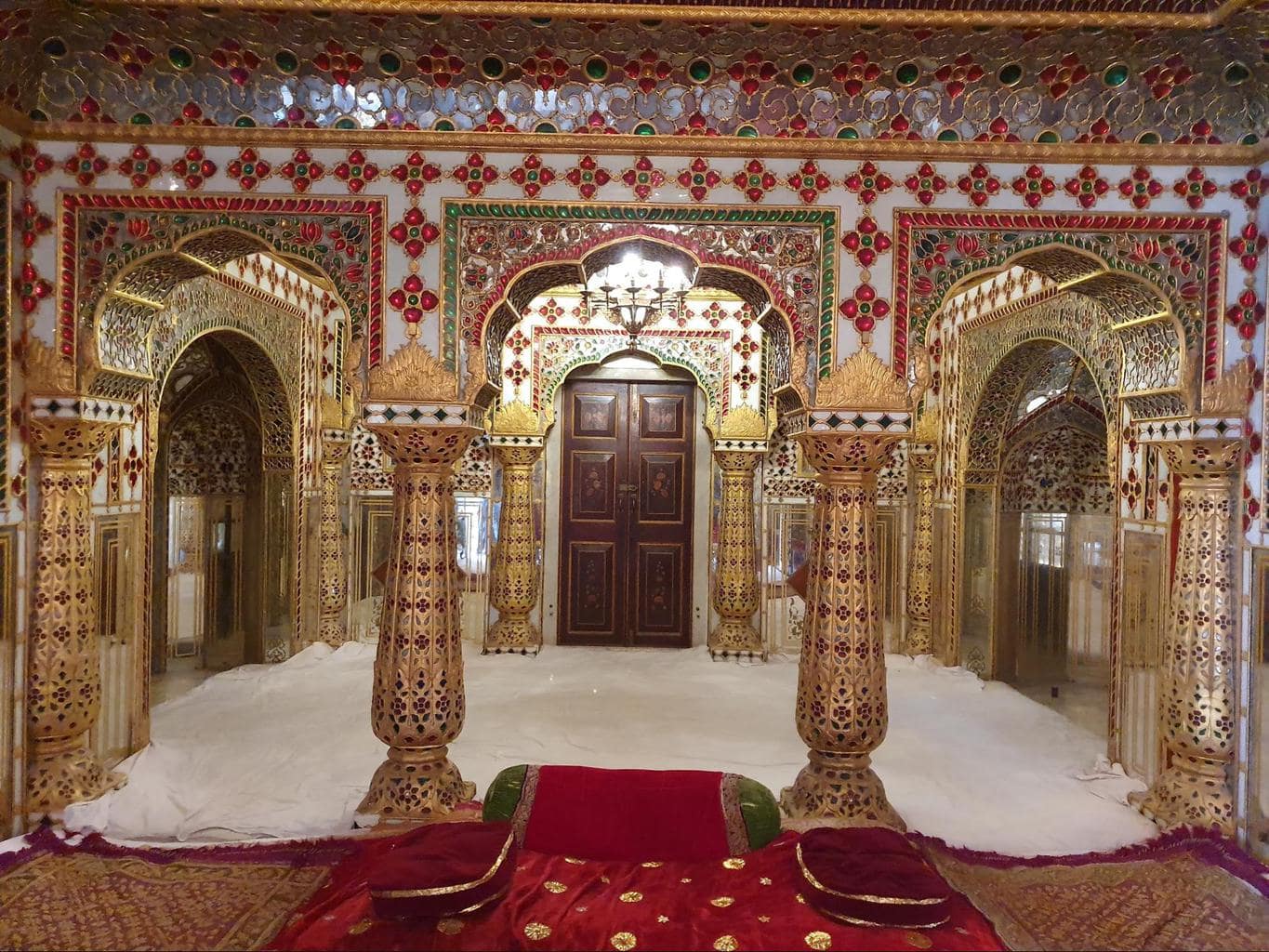
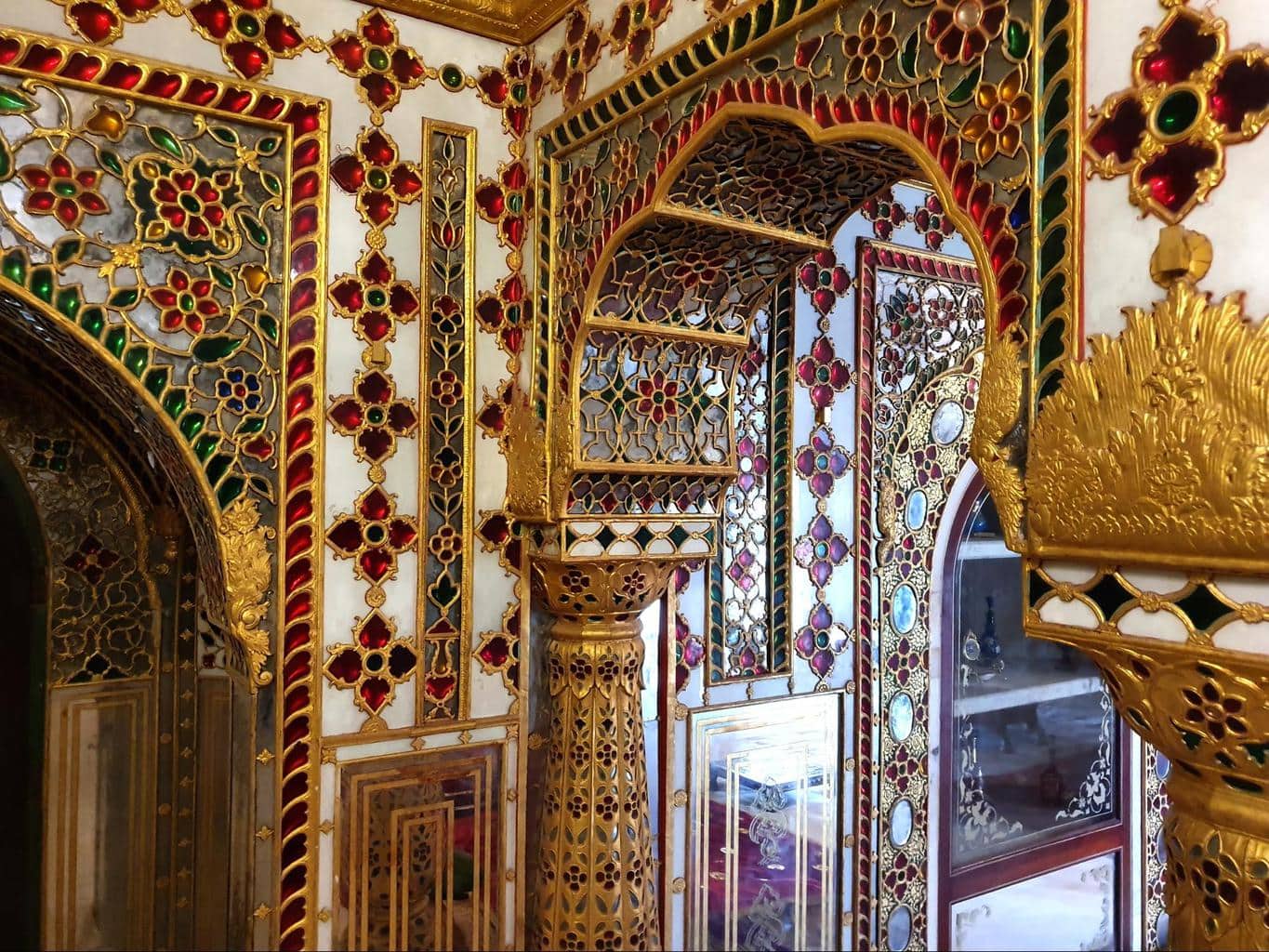
Shoba Niwas is another beautiful room decorated in gold and red, staged as it once was, with cushions on the floor and low tables. It feels as if this was for the harem, and we certainly enjoyed laying on the floor and feeling like royalty.
Because access to this part of the palace is limited, you get to really interact with the spaces under the close supervision of the guards.
Shuk Niwas is the blue room and it looks exactly like the facade of Chandra Mahal, only in the blue color that was chosen by Pantone as the color of the year for 2020 and richly decorated with flower designs in white paint.
When you reach the rooftop, look out for the Rajput flag which still flies from the palace. Note how it is one and a quarter, a distinction awarded by Mughal Emperor Anurag and which has been maintained until today.
The official palace website is here.
The best way to visit the City Palace is with a guide. Here is a great option:
- Private full-day tour which includes the fort, Jal Mahal, the City palace and lunch with a guide and air-conditioned car. This one includes it all as well as entry tickets.
There are several types of tickets you can buy for the City Palace, I highly recommend you get the Royal Splendour, this is the one I got and it gave us access to all the private parts that belong to the Maharaja’s residence and which are only open to holders of this ticket.
This means that the flow of tourists is minimal. While the main City Palace was packed, we were practically the only ones in the private area. And with reason. Instead of paying 700 rupees you pay 3,500 rupees per person, the premium ticket does weed out most of the visitors.
This premium ticket will give you access to Chandra Mahal Verandah (the floors above the ground level courtyard), Rang Niwas, Shobha Niwas & Pritam Niwa.
Have lunch at the restaurant of the Maharaja
This gem of a restaurant in the City Palace is owned by the royal family and is located in a renovated building right by the entrance to the palace, making it a great lunch stop between the fort and the palace.
Called Baradari which means “twelve doors” in Urdu, a word used widely for many structures in Rajasthan, serves a fine-dining version of traditional Indian dishes with a touch of creativity, all presented in nice plates and enjoyed in an open and bright courtyard.
Don’t expect tiny portions and expensive prices though, dishes are reasonably priced and curries are still served in copper pots.
If the heat is too much, there is also a covered and air-conditioned section under the arches that is equally pleasant and at night, there is a bar.
The restaurants renovated the palace space and made it contemporary while preserving part of its heritage with great results. Unlike other heritage dining experiences in Jaipur, here you can find a blend of old and new, a nod to the palace’s history and beauty with a 21st-century look.
No official website I could find but their Facebook page is here.
If you are visiting in the peak months, you may have to book in advance, alternatively, come early or late. The restaurant is popular with the smaller higher-end groups.
Jal Mahal
Jal Mahal, translated as Water Palace, is a 16th-century submerged palace located in Man Sagar lake, near Amer Fort. It looks like Udaipur’s Lake Pichola’s Lake Palace but in fact it is much taller.
Three-quarters of the palace remain underwater when the lake is full and will be revealed at the end of the dry season when the water levels decrease.
The lake was built as a hunting lodge for the Maharaja and its walls were reinforced in the 18th century to withstand the force of water as the walls of the dam that created the lake were strengthened.
The hope was that, come the dry season, when the palace would be visible, it would be well preserved and usable.
But centuries passed, the city grew, droughts were no longer a problem and the lake became a dumping ground filled with sewage water. As would be expected, the lake was forgotten.
In the last two decades, the government of Rajasthan has awarded projects to revitalize the lake and there is talk that the palace will be converted into a restaurant. Today, the water is much cleaner and you can see ducks, the original reason why the Maharaja built the palace as a hunting lodge.
You cannot visit the palace as it is submerged, but can only observe it from the promenade that is around it, by the main road between Amer Fort and Jaipur City palace, which is why it is a must stop and one of the most popular things to do in Jaipur.
Read more about the detailed story of the palace here.
Your driver will almost surely stop at the lake’s shore and viewpoint on the way between the fort and the City Palace but if you are on a rickshaw, ask the driver to make a pitstop.
Shopping in the Pink City bazaars
Jaipur’s walled city is a shopping paradise for anyone who wants to.
The grid streets of the Pink City are lined with shops, one after the other, and no matter where you look, you will be faced with souvenirs of all kinds and shapes.
Shops are colorful, and sell anything, from Rajasthani puppets to textiles, keyrings, spices, handbags, colorful umbrellas, you name it, they have it.
If you just want to browse around, and are cool with the constant hawking and peddling you will endure. Johari Bazaar is a good street to do so, it is the one Hawa Mahal is on. Haggling is essential here, so start at half the price (or less) and walk away, it’s not a cliche, it works.
For permanent shops, look no further than the below list.
Anhouki, sells typical Rajasthani clothing and is a well-known brand, you can even visit their textile museum where you can learn about the traditional block printing technique used in Rajasthan. There is no haggling here (thankfully!) and the prices are marked, they are also higher than anywhere else, you pay for quality and experience.
Narain Niwas Palace has a nice shopping arcade of sorts with shops selling more of the premium, high-quality and pretty items. The shops are located within the hotel complex and are well worth a look. This is also a good excuse to check out the hotel complex which has three stunning heritage buildings.
Tip: Many Indian movies have been shot here including The Best Marigold Hotel or one about Tipu Sultan.
If you are keen to buy traditional Indian outfits, check out Jaipur Pink, in the same Narain Niwas Palace complex. Here you can get stylish kurta that are so useful and practical for India’s weather and culture.
I have a few kurtas and they come in handy when traveling across more conservative countries like Pakistan, Somaliland, India or Bangladesh. You don’t have to buy the matching leggings but can wear ones you have at home, I don’t find the Indian-style leggings comfortable (high-waisted and too long so you wrap the bottom at the ankle).
Note that you need to be very specific to the driver about where you want to go, find the address and show it to them on Google maps, and then triple check they actually brought you to the right place.
Trying to do shopping in Rajasthan, and in particular in Jaipur, can be very frustrating because all guides and drivers will try and insist, repeatedly, to take you to a shop that pays them the highest commission.
No matter how many times you say no, they will still do it, so make sure that you get taken to the right place and insist if not.
Also, don’t believe it when they try to convince you that a place has closed down or moved, Google Maps tends to be pretty accurate and, to be extra sure, you can always call ahead or check with your hotel who will know.
Dig into dal bhati churma
Dal bhati churma is one of Rajasthan’s most popular dishes and it is not very common outside of the region. The dish consists of a lentil soup eaten with very consistent oiled wheat flour bread slightly bigger than a meatball.
While the dal is usually quite watery, the bread is solid, there is no fluffiness here but rather a hard consistency. After cooking the bread in an oven, it is then greased with ghee so it is oily.
How do you eat dal bhati churma?
The only way you can: by breaking small pieces of the bread and soaking them in the dal soup.
You will find dal bhati churma on every menu and beware, if you expect to finish it, you will be pretty full by the end of it.
Photograph Panna Meena Ka Kund stepwell
There are stepwells across India and if you spend any time in Rajasthan you will come across a few of them. Some are more elaborate than others, some have balconies, decorations, even part covers.
There is a popular and convenient stepwell near the fort called Panna Meena Ka Kund that makes for a typical thing to do in Jaipur because it is located on the way up to Amer Fort.
Panna Meena Ka Kund is a traditional stepwell with an almost flat surface save for a small chhatri. Because of its location and its pale pastel yellow color, it is easy to photograph and tends to have good lighting.
Just ask your driver to stop on the way up or down the Fort. Make sure not to pay an entry ticket here, even if the guard asks you to, the stepwell is free to visit and open to the public.
Beware that you will not be allowed to walk down the steps, this seems to have been banned as of 2020.
Have chai with views of Hawa Mahal
Hawa Mahal or the Palace of Wind is one of the most popular attractions in Jaipur and if you research about the city you will for sure come across this landmark without realizing that it is one at all, adjacent to the City Palace complex.
However, unlike other things to do in Jaipur which are best enjoyed inside, Hawa Mahal’s beauty lies on its splendid curved honeycomb portholed facade which helps it stand.
Painted in the same pale pink of the city and embellished with white paint designs, Hawa Mahal looks like a beehive but was conceived to look like Krishna’s hat.
The design, with lots of small windows, provided privacy to the royal women so they could observe purdah, a tradition brought by the Mughal which meant women should hide from men, cover their faces and not be seen in public.
If you pay attention to typical Mughal architecture you will notice that all buildings have intricate screens on the upper floors of major courtyards and public spaces so women could hide behind while still seeing performances or processions.
Hawa Mahal was built at the end of the 18th century for that reason above a main thoroughfare in Jaipur so they could see processions and daily life in one of the city’s busiest streets.
You can go inside and visit but there is not much to see beyond a courtyard and the back of the main facade, its interest is on seeing it from outside and, most importantly, from the cafe that is across the street and which provides fantastic views and the perfectly framed perspective on the facade.
Official website here.
In front of the palace you will find two tiny cafes called Wind View Cafe owned by a family, the son is usually around and likes to practice Spanish. There are only a handful of tables in two outside balconies and a handful more inside, in a slightly elevated space.
You come here for a drink with a view, and what a view, but be sure to enjoy it quickly so others can too. The masala chai is not bad either and is served in traditional clay glasses.
Tip: There is a platform between the two cafes from where you can also have great views.
See an Egyptian mummy
Albert Hall Museum is housed in an impressive Indo-Saracenic building similar to the major colonial structures of Chennai and is located outside of town. While this is not on the major tourist trail it is still worth a visit.
Acting as the museum for the region, it was built at the end of the 19th century, its stone foundation was laid by the Prince of Wales on his visit to the city (the same visit that gave the city its pink color).
Inside you will find paintings and objects from across Rajasthan and other parts of India and, most remarkably, an Egyptian mummy from the 4th century BC.
The museum opens from 9am to 4:30pm. If you cannot visit the museum during the day, make a pit stop at night when it is lit incredibly and looks like a majestic structure.
Photograph Patrika Gate
This new gate structure has seen Instagram stardom in recent years as its colorful arches have become major photo shoot backgrounds.
From outside, the gate looks like any typical gate in Rajasthan, but get closer and inside and you will see the incredibly colorful and intricate transversal arches that are perpendicular to the main gates.
The gate is a modern addition to the city and encapsulates a lot of its main elements in a single design. The seven internal gates each represent a part of Jaipur and has a unique design reflecting the seven gates in the city. Look at the arches to see key landmarks of Jaipur.
Behind the gate is a green park with fountains, benches and grass while most visitors will approach it from the roundabout side.
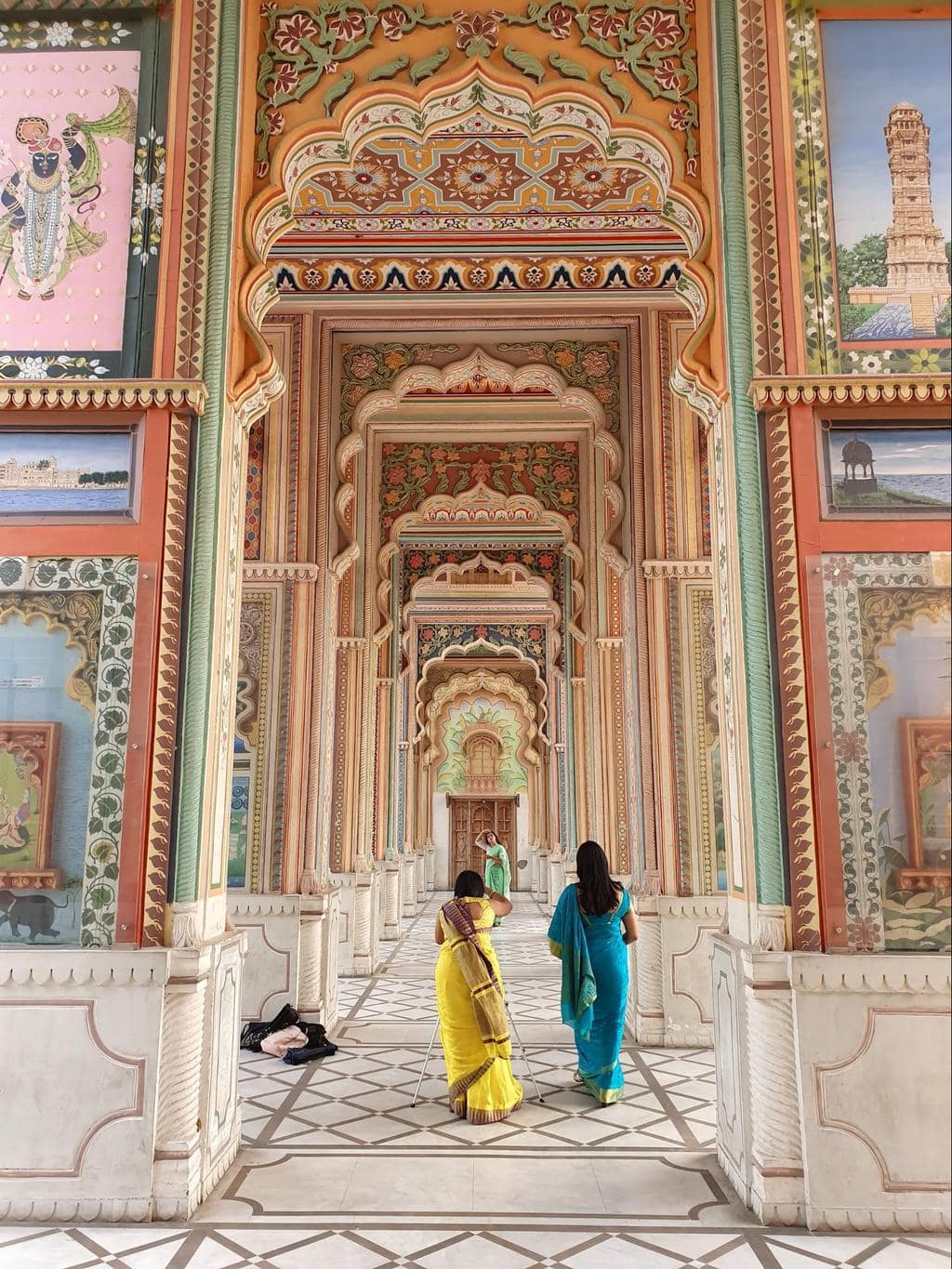
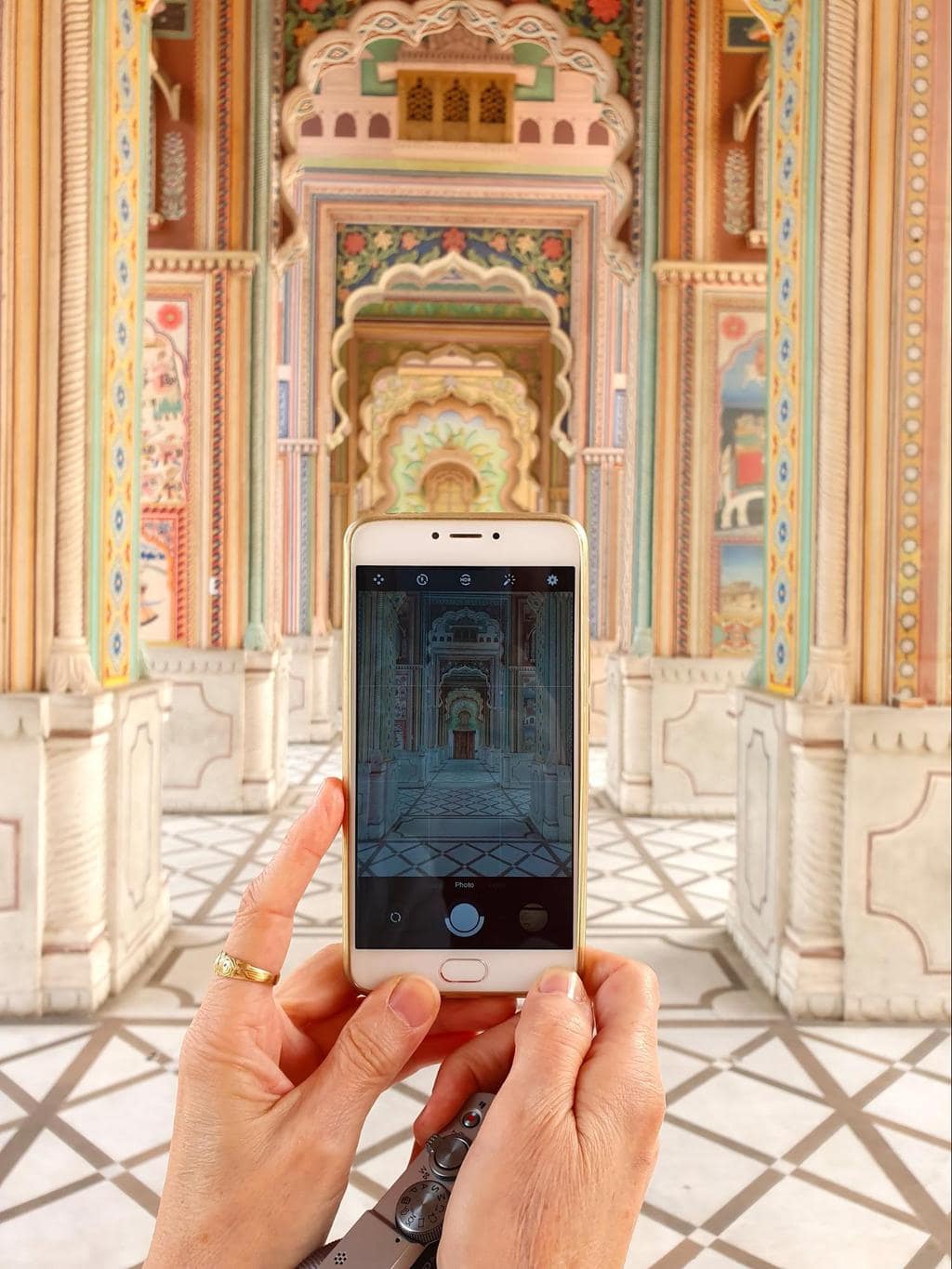
Patrika Gate is very near the airport so it makes for the perfect quick stop on your way to or from. There isn’t anything around it and there is no entry ticket or cost associated with it.
Take a food tour
One of the best things you can do in Jaipur is taking a food tour to learn more about the cuisine of the country.
India has some of the most unique foods there are and while they are often found outside the country, nothing tastes like the real deal.
The cuisine of Rajasthan will tell you as much about this part of India as any museum and is the best way to learn about its heritage through the sense of taste.
Book this food and snack tour which includes a few typical Indian dishes, a cup of masala chai (my favorite!) and a bit of history to go with it in a casual and quick tour.
Or go for the longer version to taste twice as many dishes and learn even more and make it a full and filling meal. You can expect tandoori dishes (cooked in a tandoori oven, typical of Rajastahn), breads and vegetables to be included.
Visit Chand Baori stepwell
There are stepwells and then there is Chand Baori, in the village of Abhaneri.
The famous stepwell is located about 1.5h from Jaipur and is one of the most impressive and oldest ones in India. It makes for a good half-day trip, not just for the stepwell but also to enjoy rural Rajasthani life.
Chand Baori was built in the 9th century and has been featured in many famous Indian movies. The mesmerizing symmetrical steps look like they are an illusion, an impossible object by Escher that can’t be real.
You can’t go down the steps at Chand Baori but there are plenty of opportunities to photograph it anyway. There are also statues and other objects on display on the corridors around it and the guard will show you laminated scenes from popular Bollywood movies that were filmed on location.
Next to the stepwell is a small temple dedicated to Durga.
There is an entry ticket to Abhaneri and the stepwell is best visited on a day trip from Jaipur combined with Bhangharh Fort or with the Monkey Temple.
Book your tour of Abhaneri and Monkey Temple here.
Mingle with the monkeys at their temple
A monkey temple has to be one of the most intriguing things to do in Jaipur.
If you travel across Rajasthan you will have seen monkeys frequently. Apart from being cheeky and stealing your lunch, monkeys also can represent the monkey god Hanuman, one of Hinduism’s most revered, and it is common to find many around temples.
About 10km from Jaipur there is a temple complex that is a popular attraction and is casually known as Monkey Temple, or Hanuman temple, although its official name is Galtaji.
The nickname comes from the fact that there are a lot of monkeys living here, especially around one of the temples devoted to Hanuman.
The monkeys became even more famous after an episode filmed by National Geographic titled Monkey Thieves that followed a troupe of 60. But beware, these are truly smart monkeys and they sure know how to steal anything within their reach.
Although a lot of tourists visit the complex to see the very skilled monkeys, the temple complex is inherently interesting.
Sandwiched between the Aravali hills in a picturesque and very photogenic location, the temples are crossed by a stream that flows over several pools where pilgrims come to bathe.
Galtaji Temple can be visited as part of this full-day Jaipur tour. Alternatively, if you book a private tour of Jaipur you can ask to be taken there.
Be very careful with the monkeys, they are cute and photogenic but they will steal things from your hands.
I have seen them steal cameras from the hands of tourists, battery packs, mobile phones from pockets and even wallets. Lock everything in your bag (which they have also learned to open) and strap everything else to you.
Visit a haunted fort
Bhangarh Fort has been touted as India’s most haunted place and that means it attracts a lot of people who are curious about it and it also deters a lot of people who believe it is.
Just to make a point that this is not an unfounded claim, there is a sign put up by the Archeology Survey of India that supports that claim and states that it is not safe to be here from sunset to sunrise.
So why is it haunted?
Legend has it that the 16th-century village and fort were the objects of a curse.
The king of Bhangarh decided to hire a magician to send black magic spells onto his enemies in an effort to keep the city safe.
However, the magician fell in love with the Queen and tried to make her fall in love with him using a magic potion.
The king found out and, unhappy, the magician set out to destroy the city by raining rocks on it. Many villagers managed to leave on time, but others were not as lucky.
The fort and village remain abandoned for centuries and what you can see today are the ruins, some parts are better preserved than others, for example, the fort is in a dire state but some of the temples are still standing, but all are worthwhile.
Read my full article on Bhangarh Fort.
You will have to book a driver and car to visit Bhangarh Fort as it is located between 1.5h and 2h from Jaipur City. It is best to pair Bhangarh Fort with Chand Baori in Abhaneri as they are nearby.
Adventure on a tiger safari at Ranthambore
Jaipur is the gateway to one of India’s most famous tiger safari spots and makes for a great base from where to see these stunning creatures.
Ranthambore National Park is where I saw my first tigers, a mother and her cubs, and it was one of the most beautiful experiences ever. This is one of the parks in India where these beautiful endangered animals live.
India is one of 29 nations that still have wild tigers and it is also the only country where the wild population has been increasing. There are not a lot of safari spots in Asia, but Ranthambore is one.
The park is located about 3h drive from Jaipur, so the day will be long, but it is totally worth it to see one of the close to 3,000 tigers that exist in India across all its parks.
After years of decline, the population of tigers is finally increasing. However, like with any real wildlife safari, seeing tigers is not guaranteed and it is heavily dependent on your luck and on the time of year.
It is usually much easier to see tigers toward the end of the dry season when the water has become scarce and they are forced to congregate near the water sources and also the grass is lower, drier and shorter, making their spotting much easier.
The official website of the government is here, the rest of the results you will see when you do an online search will take you to fake websites set up by tour companies to trick you into booking thinking you are on the official one.
Book the day trip to Ranthambore here.
You have the option of choosing the group safari on a canter or the private option in a jeep, I highly recommend you book the jeep, you don’t want to spend such a long day driving (3h each way plus another 3-4 on a safari) and then be uncomfortable.
Or worse, spot the tigers and then not be in a position to photograph them properly because you don’t have space or are in a middle seat.
Remember to dress appropriately to be in an open jeep or car in the afternoon when the sun is strong, and wear a hat and sunscreen. Long sleeves are a good idea too.
See the city from a hot air balloon
Can you think of anything more romantic than a hot air balloon ride?
I love hot air balloons so much that I have taken rides in Napa Valley, over the Masai Mara National Park in Kenya, over Sossusvlei and NamibRand Desert in Namibia.
Deserts make for magical places to go on hot air balloons because the colors of the sand and the shadows create stunning patterns at sunrise, not to mention the fort and other landmarks in Jaipur.
Can you imagine the city walls and the pink facades from the sky?
You can book a hot air balloon ride in Jaipur here, I promise it will be a memorable experience, perhaps the most unforgettable of all the things to do in Jaipur.
Stay at a royal palace
Jaipur is perhaps the most regal of the cities in Rajasthan and the one where more forts and palaces have been developed into luxury hotels that take you back to the time of the Rajput Kingdoms.
Nothing speaks better to the city’s past than staying at one of these historic properties.
We have written an article about the best hotels in Jaipur, but there are a few heritage buildings that deserve special mention.
Samode Haveli and Samode Palace are both stunning properties that have been renovated while keeping with their haveli heritage. Havelis used to be ancient inns along the trading routes and some of them have incredibly intricate designs and colorfully painted walls.
For an extra dose of luxury try the Sujan Rajmahal, where bright pastel colors take the decor to the next level and you will feel like a real prince or princess.
Just outside Jaipur are three royal gems: Alila Fort Bishangarh, Six Senses Fort Barwara and Amanbagh. All three replicate what it must have been to live like a king or queen at the time of the Rajput.
If you are ready, book your hotel on Booking.com or on Agoda.
Dine like a royal
It is easy to visit Jaipur and be carried away to a world of palanquins, Mughal architecture, mirror rooms and stained glass.
But if you are not able to stay at one of the best heritage properties, another way to experience royalty just for an evening is by booking dinner at Rambagh Palace.
Rambagh Palace is perhaps the most luxuriously exuberant of the properties, and also the one where the Maharaja used to live. Currently a Taj Hotel, Rambagh Palace was built in 1835 and went through several lives until today’s hotel reincarnation.
The royal family lived here until 1957 and the Maharaja’s room is available for a night’s rest like a King.
For those looking to simply enjoy a meal, the main fine dining restaurant does royal elegance and opulence like no other place in Jaipur. Make a booking and walk through the hotel’s lobby and corridors to reach a hall dressed in gold and sparkling chandeliers.
Suvarna Mahal serves a royal Rajasthani thali that will give you a glimpse of palace life. Plates are from Versace, there is silver cutlery and water glasses, massive crystal wine glasses and the decor is more 18th century Versailles than India, but we’ll take it.
The restaurants are open to non-guests, you just need to make a booking ahead of time.
Where to stay in Jaipur
Jaipur has the widest range of accommodation options of any other city in Rajasthan and you can find everything from really affordable hostels to premium hotels fit for a king (quite literally).
I wrote an entire article with the best hotels in Jaipur, but below is an abstract with a selection of a few of the best to stay in the city.
- Samode Haveli is where I stayed on my last trip. It is centrally located in the walled city and housed in a historical haveli. All rooms are different but the hotel recently opened an extension with new rooms that replicate the heritage style. The common spaces are leafy, green grass gardens, a peaceful pool and outdoor breakfast served under the shade of trees makes for a good start to any day. The library room is breathtaking, with painted walls, floors and ceilings that look like the City Palace. Book on Booking.com | Book on Agoda
- Samode Palace is the palatial version of Samode Haveli and takes interior designs to the next level with stunning rooms that look like they were taken straight from the City palace. Book on Booking.com | Book on Agoda
- Taj Rambagh Palace was the former residence of the Maharaja and is a true luxury hotel with a heritage heart. This is where royalty and celebrities have stayed in Jaipur over the years. Book on Booking.com | Book on Agoda
- Sujan Rahmahal is the jewel of the Sujan crown, a high-end Indian hospitality brand that focuses on the design and brings the heritage buildings a modern twist. Book on Booking.com | Book on Agoda
- Oberoi Rajvilas brings the signature luxury and attention to detail of the Oberoi brand to Jaipur. The hotel is new but was built around an 18th-century temple. This is a resort-style option not too far from the city center where the whole family will have a good time. Book on Booking.com | Book on Agoda
If you are looking or a peaceful stay in the countryside, there are even more amazing options near Jaipur.
- Amanbagh is housed in a new building on what used to be the hunting lodge of the Maharaja. Aman’s invisible hand is ever present and the pink stone spacious rooms built to resemble Jaipur’s historic palaces are stunning. Keep checking for updates on their website.
- Opening in 2020, Six Senses Fort Barwara is set in a renovated 14th-century fort outside Jaipur and is the latest addition to Jaipur’s luxury hospitality scene. Located on top of a hill, the project was a major undertaking for the brand and brought an abandoned fort to life through just 48 rooms. Keep checking for updates on their website.
- Alila Bishangarh Fort is housed in another old fort, this time a defensive structure right on top of a hill, that looks as if it grew from the rocky cliff’s edge. Providing panoramic views around it, every detail was thought out to incorporate the building’s history into the modern design. Book on Booking.com | Book on Agoda.
When to visit Jaipur
Jaipur is a semi-desert city and, as such, suffers from extremely hot temperatures in the summer months, these are also the Monsoon months and are to be avoided.
The best time to visit Jaipur is during the dry winter months between October and March. In fact, the very best months are January and February when temperatures are still pleasant and there is no rain, clear skies and minimal pollution.
Sadly, Jaipur suffers from terrible pollution during the months of November and December, when the Monsoon season ends and farmers practice slash and burn to get the fields ready for the new crops.
During those months, smoke in the air can reach high levels covering the city in a layer of smog and haze that is not only terrible for pictures but also for your health.
You can see historical levels of haze on this link. The PSI level indicates the number of particles in the air and is what you should be looking at.
How to get to Jaipur
Jaipur is the easiest city in Rajasthan to get to because it has the only international airport. From here, you can get connections to several major hubs including Dubai, Bangkok and Kuala Lumpur. There used to be direct flights to Singapore but those were canceled.
Domestically, Jaipur is well connected in India with direct flights to all major cities, from Delhi and Mumbai to Amritsar, Bangalore, Chennai or Hyderabad.
If you are traveling across Rajasthan or on a tour of the Golden Triangle, you will arrive by road. Jaipur is well connected by road and is located about 5h from Agra, 6h from Jodhpur and 7h from Udaipur.
What to pack for Jaipur
Traveling to Jaipur requires proper packing. Although you will find most of the below for sale across the touristy areas of every Indian city (this goes to show how important these items are) it pays to bring the brand that works for you.
Here are a few of the things you should bring to Jaipur.
- Sunglasses, you will not go very far without them. Remember that the sun is very strong in India in general but here even more because the rays reflect on the water. Also, the wind can pick up a lot of dust which will end up in your eyes. Bring a pair of trusty and safe sunglasses. I always use Oakley (I have for decades, literally since I was 16) and they are a lifesaver. They are not stylish or fancy, but they are incredibly useful to protect from the sun and from the sand. I have used this exact polarised model for years.
- A hat to protect from the sun. You will be under the sun everywhere you go so a hat is essential.
- Mosquito repellent, even at the fancy hotels, mosquitoes will find their way in. I always use either the brand Off! or Repel. They just work and are sold in small bottles that I can easily carry around.
- Sunscreen, like sunglasses and hats, sunscreen is a critical items when traveling anywhere that is hot and sunny. As there is little shade in Jaipur, you need to protect your face and arms from the sun with adequate sunscreen, and reapply. I always use Biore because it is dry, non oily and I can even apply make-up on top of it. It comes in handy small bottles that can easily slip in my handbag and go through passport controls.
- I would recommend wearing closed shoes in Jaipur (everywhere in India really), to protect them from the sun, the mosquitoes, the dust and the dirt. I always wear flats like these ones because I find trainers too clunky.
- Ear plugs, many high-end hotels will give them to you, placing them on the bedside table, but it is a good idea to bring your own. Simple ones usually do, or you can get a more high-tech version.
This would make a great addition to your India Travel Pinterest boards!
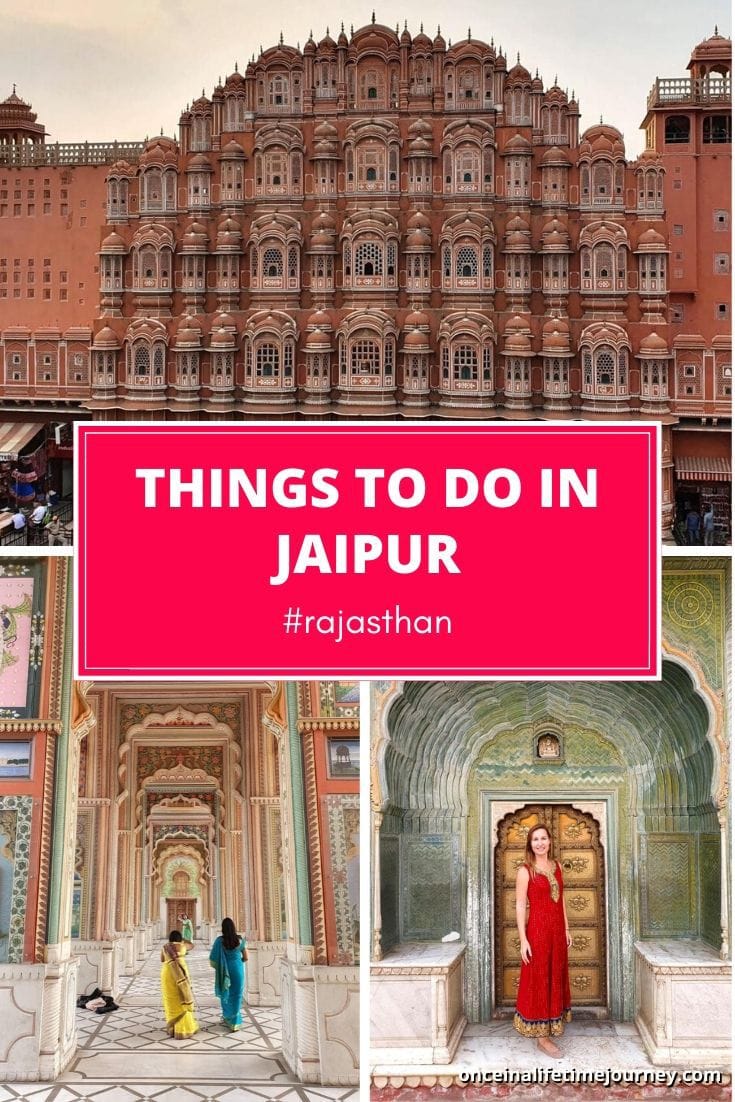
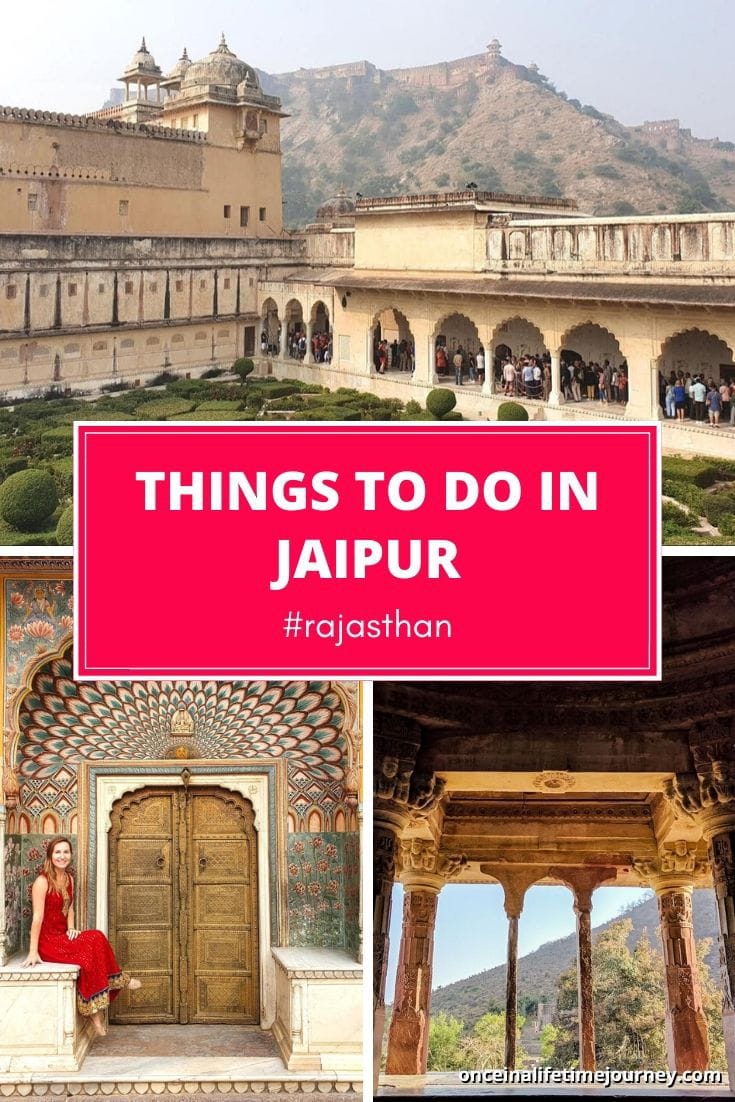
- Check if you need a visa, get help processing it at iVisa.
- Never ever leave without travel insurance. Get affordable coverage from World Nomads or long term insurance from Safety Wing.
- I find all of my flights on KAYAK. Check their Deals section too.
- Search for all your transportation between destinations on the trusted travel booking platform Bookaway.
- I book all my day trips and tours via GetYourGuide, they are the best and their tours are refundable up to 24h in advance.
- Get USD35 off your first booking with Airbnb.
- Compare hotels EVERYWHERE at HotelsCombined and book with Booking.com.
- Compare car rental prices at Rentalcars.com

